66 Halloween Home Decor Ideas 2025 That Are Spooky, Stylish & Budget-Friendly
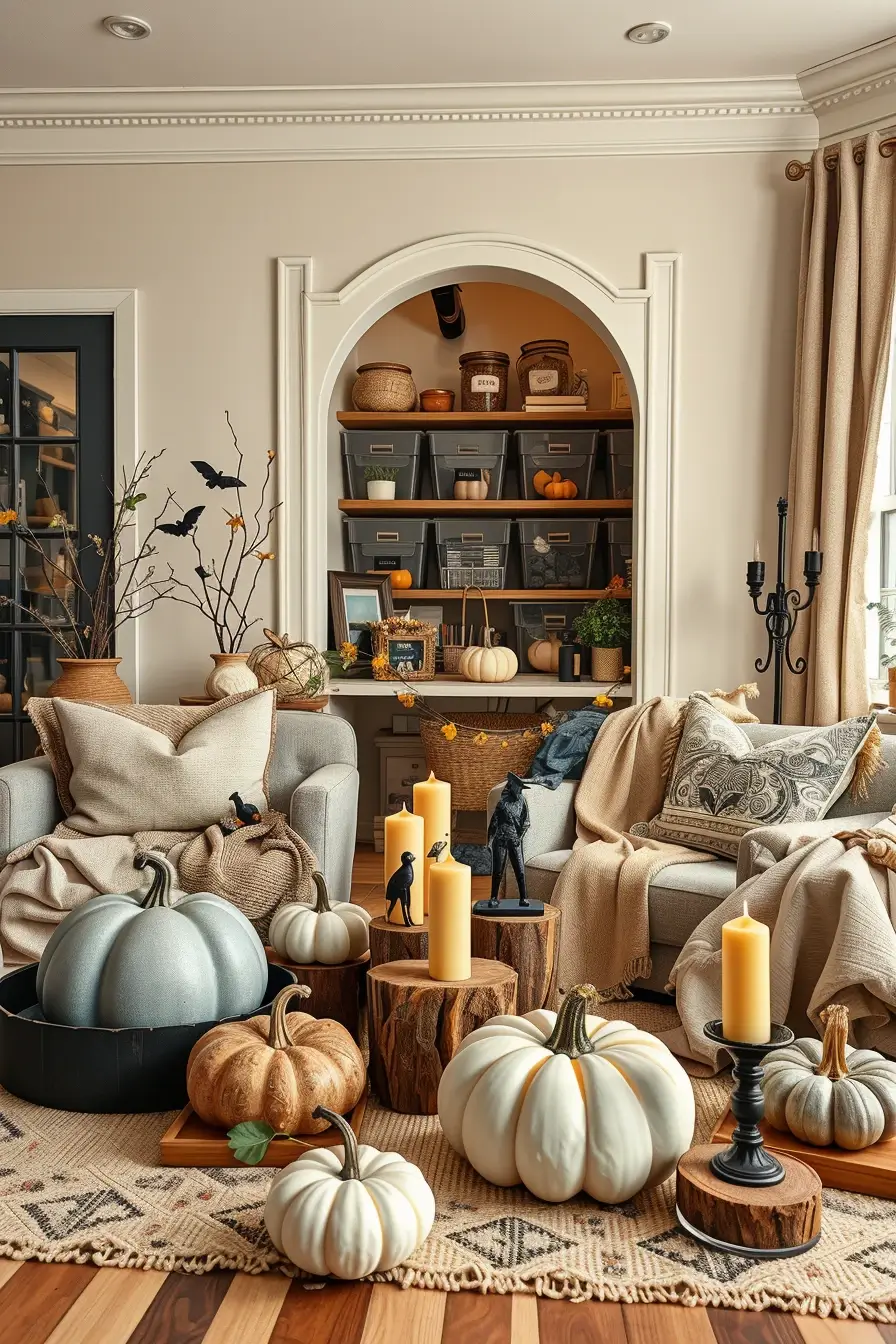
Which Halloween home decor ideas 2025 trends actually feel modern (not kitschy), which ones are truly budget-friendly, and how can you blend indoor coziness with clever DIY tricks that still look luxe? I deconstruct seven high-impact areas of the house below, in my own designer-eye voice, and you can copy, adjust, or expand to your own home. After these sections you’ll find tight to generate realistic, full-room visuals that match every idea.
Indoor Haunted Living Room Ideas: Cozy, Aesthetic & Budget-Friendly
I begin the living room with a base of somber fabrics, dimmable smart light, and a subdued color scheme of charcoal, bone, and aged brass, since Halloween home decor ideas 2025 are about classy creepiness, not tacky tchotchkes. I thrift frames, buy peel-and-stick bats, and rely on programmable LED candles to provide flicker without the fire hazard to make it affordable. I would like the room to be intimate and filmic, so I will pre-plan pools of shadow, soft pools of amber light and micro-vignettes that will be beautiful indoors and on camera.
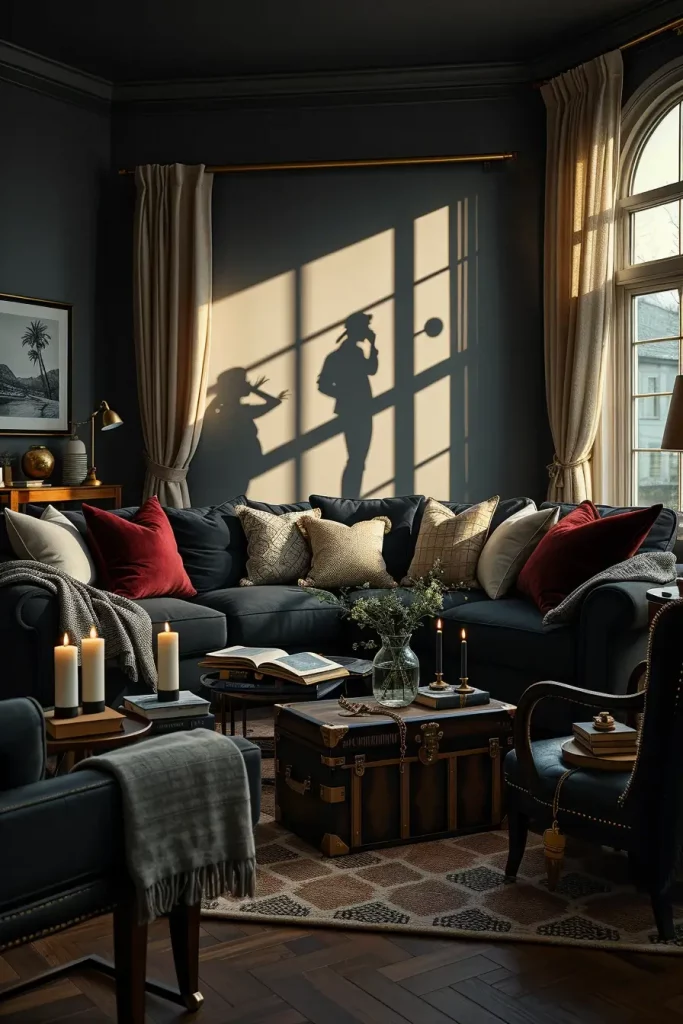
Item by item, I bring in a black slipcovered sofa (washable = practical), chunky knit throws, velvet pillows in oxblood and slate, and a low vintage trunk as a coffee table for “Victorian curiosity cabinet” vibes. I pile matte-black taper candles, stacked antique books, and faux crow figurines on a brass tray; fasten lightweight cheesecloth on curtain rods to create a quick “cobweb voile” effect; and install a discreet projector to project slow-moving shadow silhouettes on the wall. Since I am fond of adjustable lighting, I scatter Wi-Fi LED puck lights in lanterns and under shelves to make floating lights.
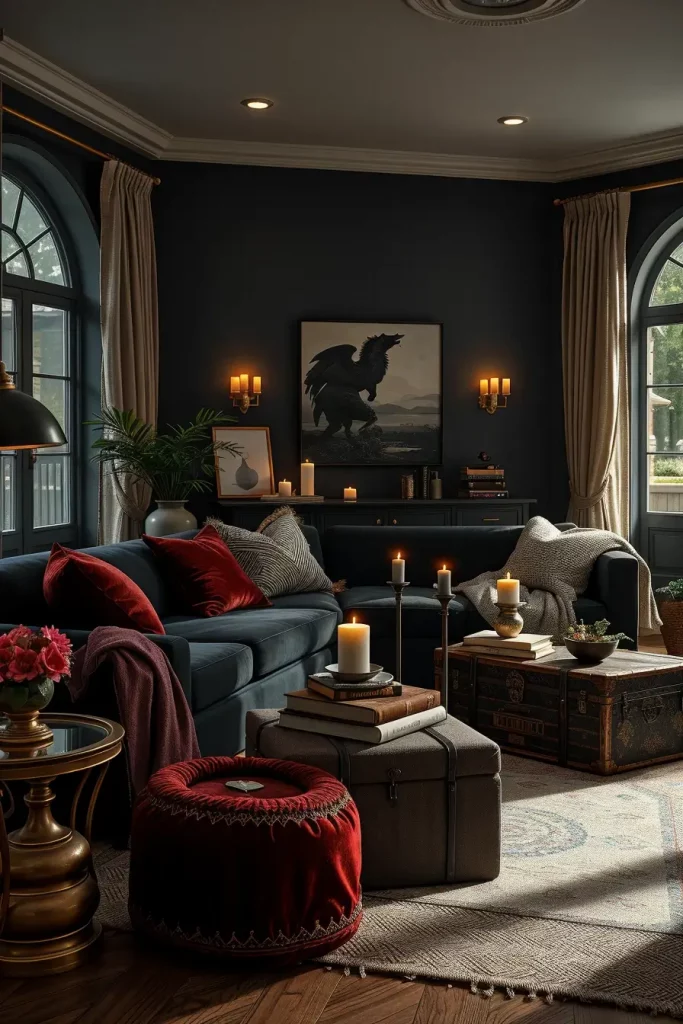
From experience, I’ve learned that limiting the palette (two darks, one light, plus one metallic) keeps everything cohesive—Apartment Therapy’s stylists often emphasize this same discipline for seasonal styling. I also keep pathways clear (no trip hazards), and ensure every prop is either soft, stable, or secured—especially if kids or pets are around.
What’s missing? I would include a subtle fragrance plan: smokey incense cones or diffusers with cedar, clove and vetiver notes. The invisible layer that sells the scene is scent.
Gothic-Inspired Dining Room Decor For A Dramatic Feast
In the dining room, I get maximal: floor-length black tablecloth, gauzy topper, tall candelabras, and a gothic color scheme of jet, burgundy, and tarnished silver. The idea is to have dinner as a theatrical performance moody, immersive, and comfortable. It is like a cathedral dinner party, only on a smaller scale, in an apartment or small house.
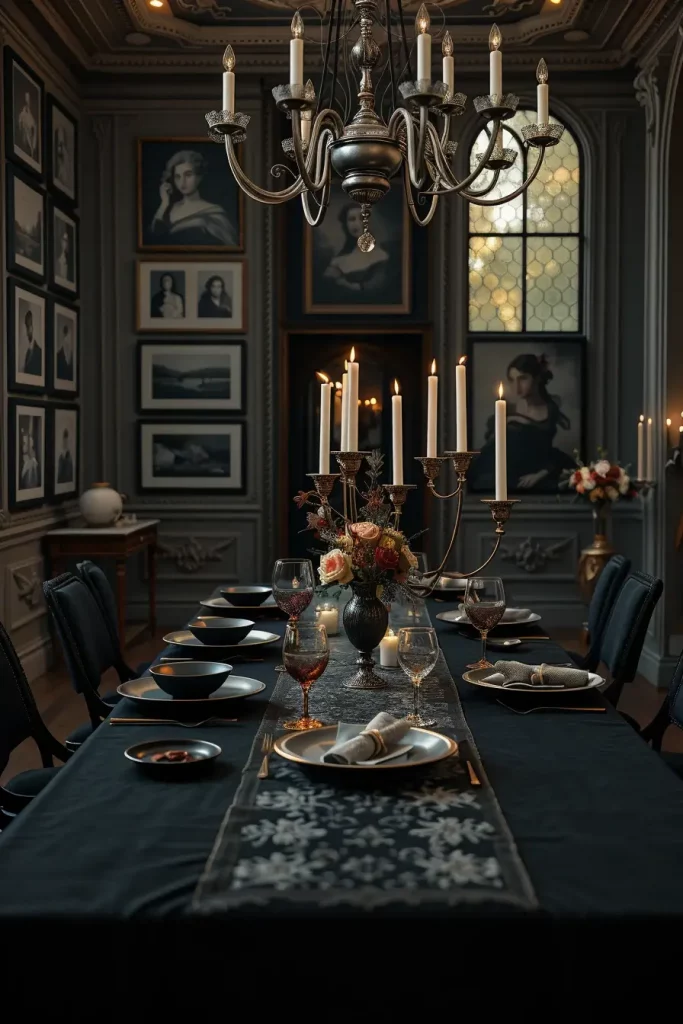
I laid the table in matte-black dishes, bone-handled knives and forks, and smoky glass tumblers. Velvet runners, dripping taper candles (battery LED or real if safe), and vintage silver trays styled with faux taxidermy butterflies and old keys add layers of story. I group asymmetrical black frames with moody artwork prints and oval mirrors on the wall to reflect flicker. Chair backs are fastened with black ribbon and one dried flower to add a little drama.
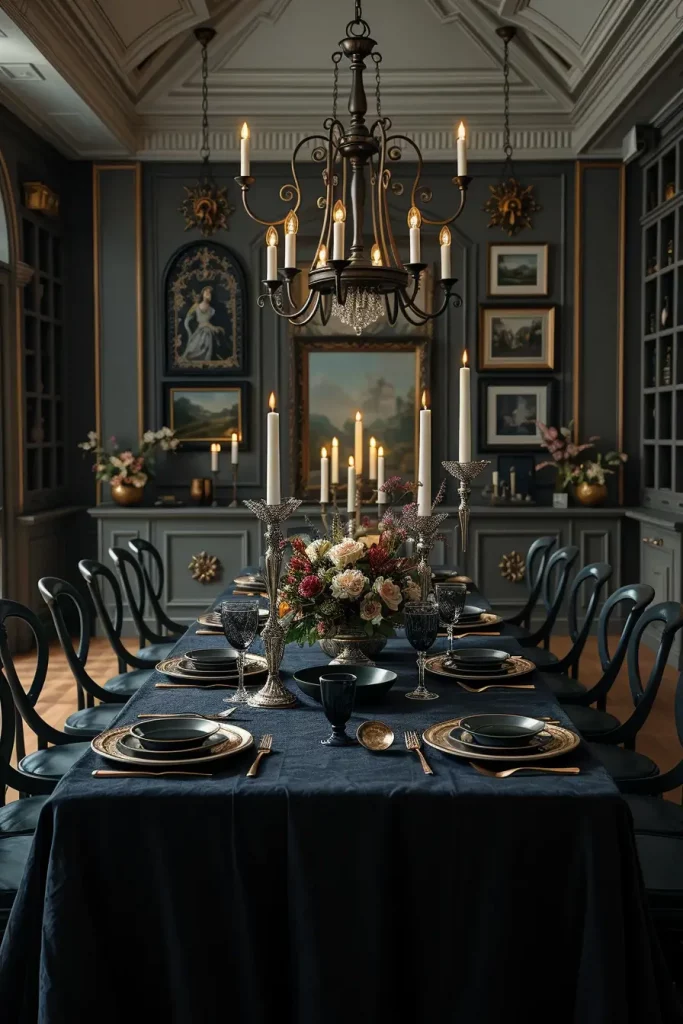
I’ve found (and AD’s stylists agree) that height variation is key—tiered cake stands, stacked books, and risers create that lush, altar-like silhouette. I also keep a dimmable overhead fixture and supplement it with lamps, so the room reads soft on faces (no harsh downlight at dinner).
To take it to the next level, I would add projection-mapped stained-glass effects on the walls or ceiling, a cathedral-glow effect- cheap mini projectors make this a trick within reach in 2025.
Chilling Fireplace Mantel Displays With Layered Textures
When I style a mantel, I think in vertical layers: back (statement mirror or oversized antique frame), middle (stacked books, apothecary bottles), and front (LED taper candles, cloches, mini skulls). The depth is achieved by the texture story matte, glass, aged metal and tattered fabric, but there is no visual noise. It is one of my favorite DIY playgrounds since minor replacements can change the atmosphere in a short period.
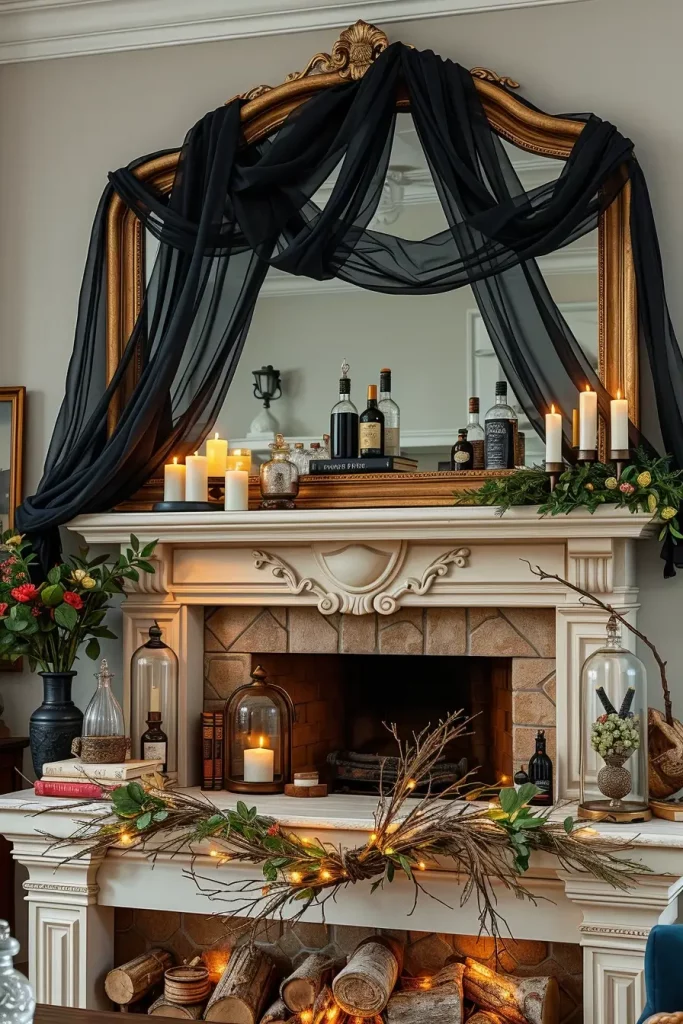
I will place flameless LED tapers at varying heights along the mantel, place smoky glass apothecary bottles in, and cover edges with black cheesecloth. A huge distressed mirror is the portal, and it is decorated with twig garlands and black paper moths. I put pillar candles in the firebox at different heights or birch logs wrapped in micro string lights to create a ghostly ember look, as shown below.
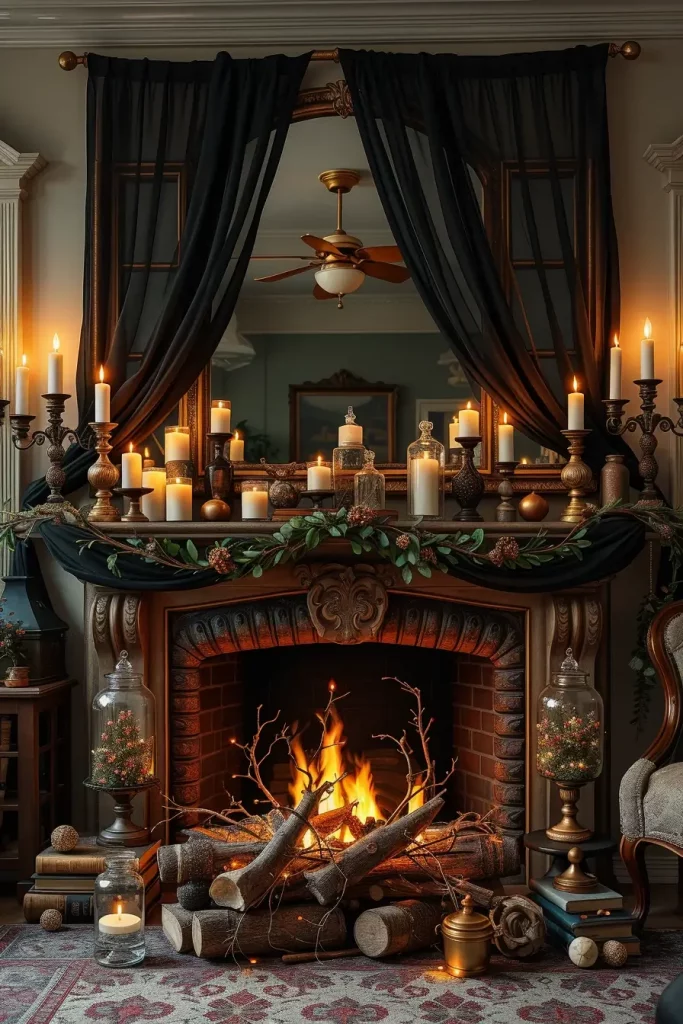
At work I never test lights in the daytime first, what looks spooky in the day can be flat at night. Stacking smart plugs allows me to activate all of them simultaneously. Designers at house beautiful frequently shout out layered texture as the quickest way to visual richness; I could not agree more.
If I add one more thing, it’s motion-reactive sound (a subtle crackle or whisper) triggered when someone walks past—cheap PIR sensors and Bluetooth speakers can do wonders.
Creepy Kitchen Counter Styling: Potions, Apothecary Jars & LED Cauldrons
At home, I am more functional in the kitchen: the areas have to be cookable, but it does not imply that it cannot resemble a witch lab. I group styling to corners and open shelves, and prep area is free. My anchor: a diminutive LED smoking cauldron atop a wooden riser, flanked by labeled brown apothecary jars, creepy specimen cloches and faux herbs hanging on iron hooks.
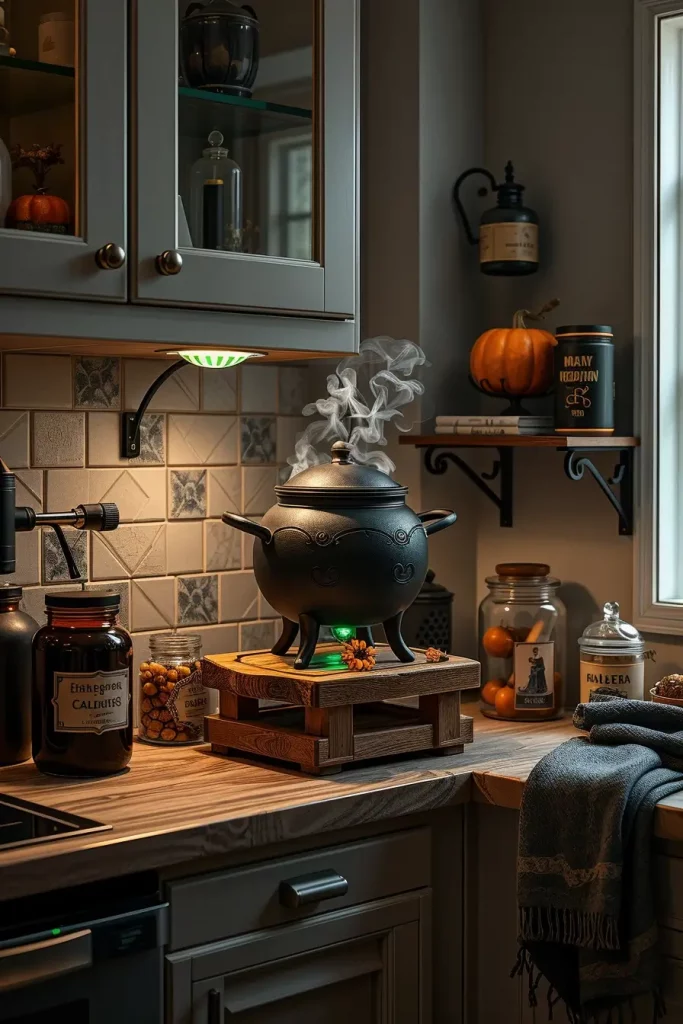
Each thing pays its own way. Apothecary jars store real ingredients (tea, dried citrus, star anise) for function-meets-theme; a black tray corrals vials and droppers; matte-black ceramic canisters hide everyday utensils; and a discreet fog machine tube threaded behind the backsplash adds drifting mist during parties. I replace white dish towels with charcoal and put in a motion sensor to activate a gentle green light under the cabinets.
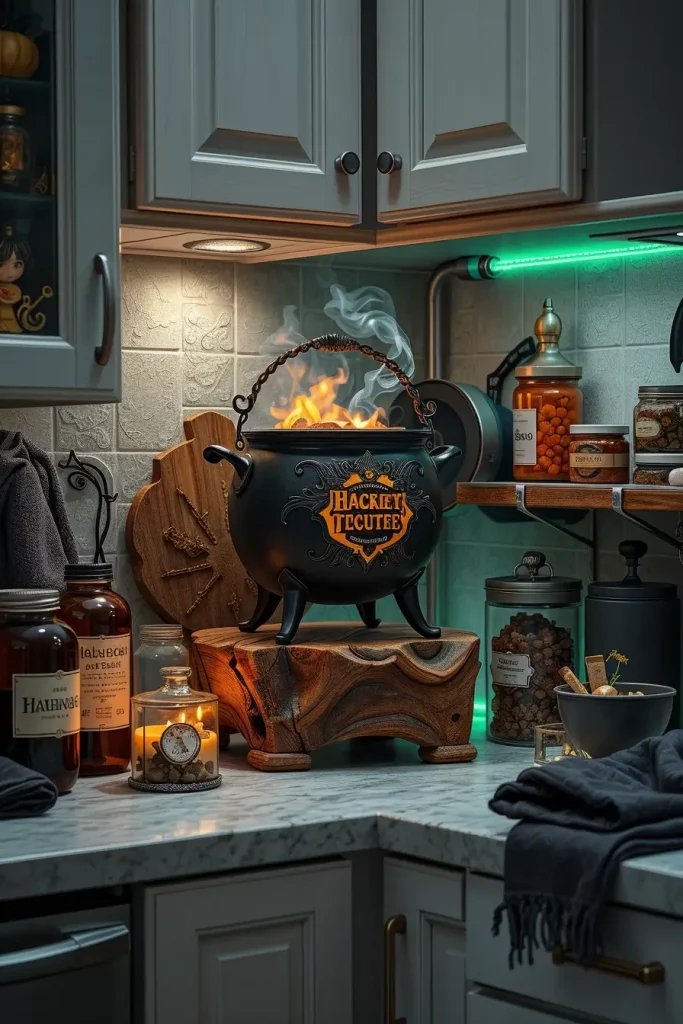
Less is more in a work zone-I have learned the hard way that there is too much of everything in a work zone- The Kitchn constantly reminds the readers to guard the workflow and I religiously adhere to this rule. I decant as much as possible as well, so it is always labeled and the appearance is not cluttered.
To get even more, I would include projection boiling effects on the backsplash or a mini digital frame that cycles animated potion recipes- fun, theme-appropriate and easily turned off after October.
Eerie Bathroom Decor Ideas: Mirrors, Fog, And Motion Sensors
Bathrooms are ideal locations of jump-scare technology since they are small and reflective. I start with dim, LED-strip backlighting behind the mirror, a motion sensor that triggers a low red glow, and a discreet ultrasonic fogger inside the vanity (vented through a cracked drawer) for short spurts of mist. The rest is restraint: monochrome towels, matte-black pump bottles, and a single eerie floral (like black eucalyptus) in a slim vase.
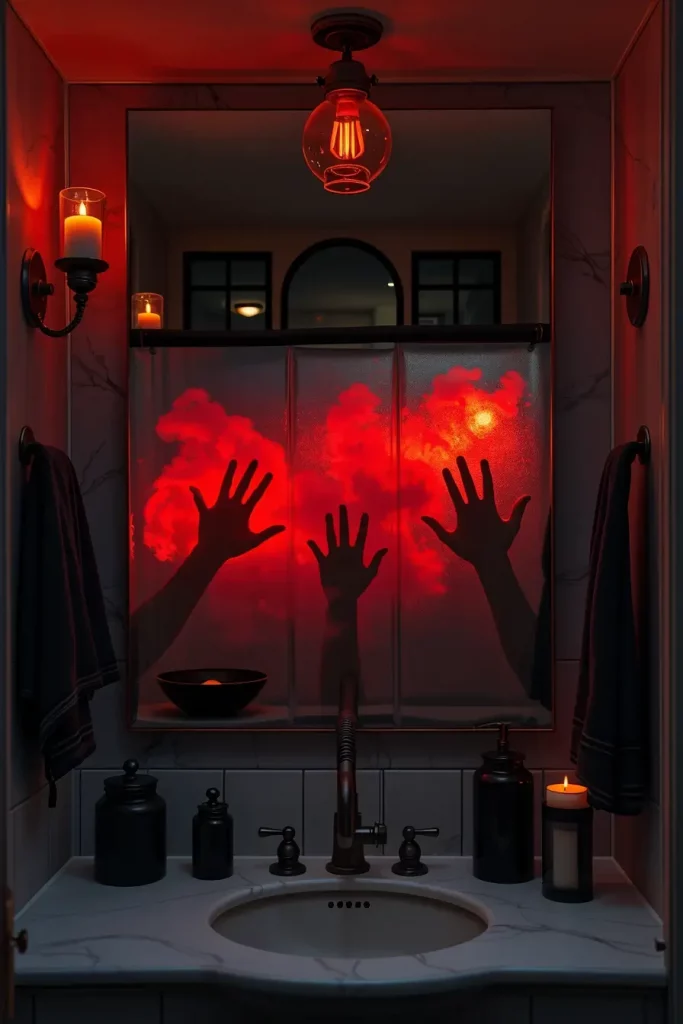
Mirrors, hooks, and jars in smoked glass and matte-black finish unify the palette and do the heavy lifting: black-framed mirrors, matte-black hooks, and smoked glass jars. I put peel-and-stick shadow hands in the shower or behind frosted glass, replace the bath mat with a charcoal one, and small floating LED tealights in the sink during parties to instantly get a haunted hotel vibe.
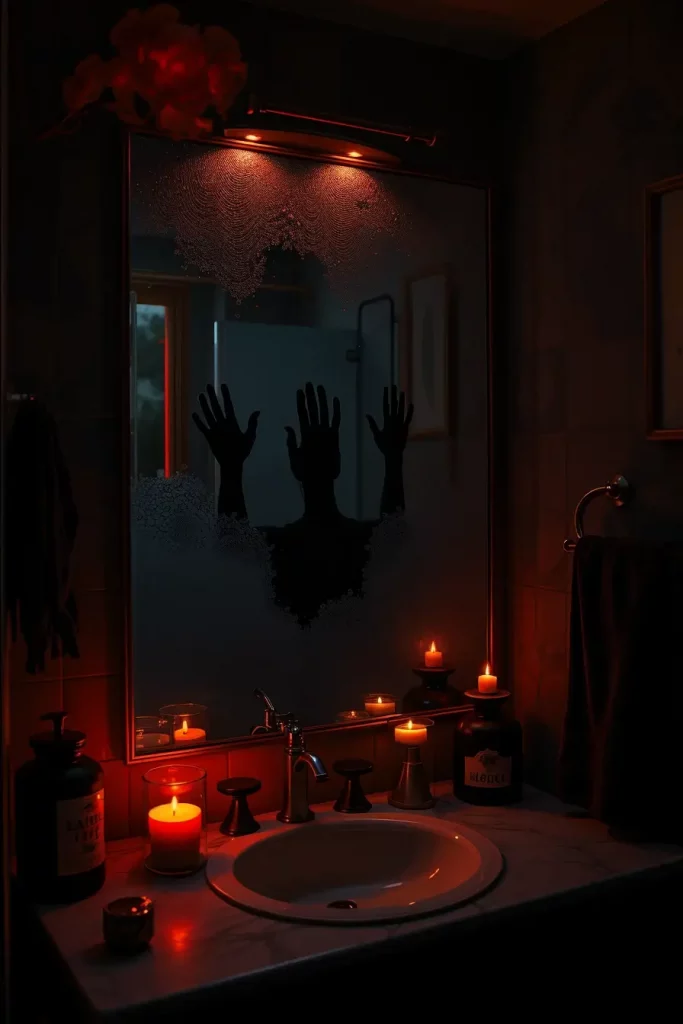
Design professionals will tell you that bathrooms are only to be played with light-I concur. Any effect is enhanced by reflections, steam and mirrors and I experiment with angles prior to the arrival of guests. I also make sure that the ventilation is sound no one wants a fog machine to trigger the detectors.
What’s missing? Ambient sound. I would put a small waterproof Bluetooth speaker behind the toilet tank and loop some light drips, muffled whispers, or a dusty phonograph crackle.
Haunted Bedroom Concepts: Luxe, Dark And Comfortably Spooky
I have a dark boutique hotel approach to the bedroom: luxurious fabrics, bedding on bedding, and sparse props. A black or deep-plum duvet, velvet pillows and a gauzy black canopy or bed crown will instantly change the mood. The lighting plays an important role, dimmed warm LED light bulbs, bedside lanterns with flicker settings, and an art light with a low light above a dark framed print.

The furniture stays practical: an upholstered headboard (great for comfort and acoustics), dark-stained nightstands, and a vintage trunk at the foot of the bed for storage and scene-setting. I decorate small cloches with dried flowers, old books, and brass candlesticks with flameless tapers on the top. A long mirror with a distressed frame is leaning nearby to reflect candlelight to add depth.
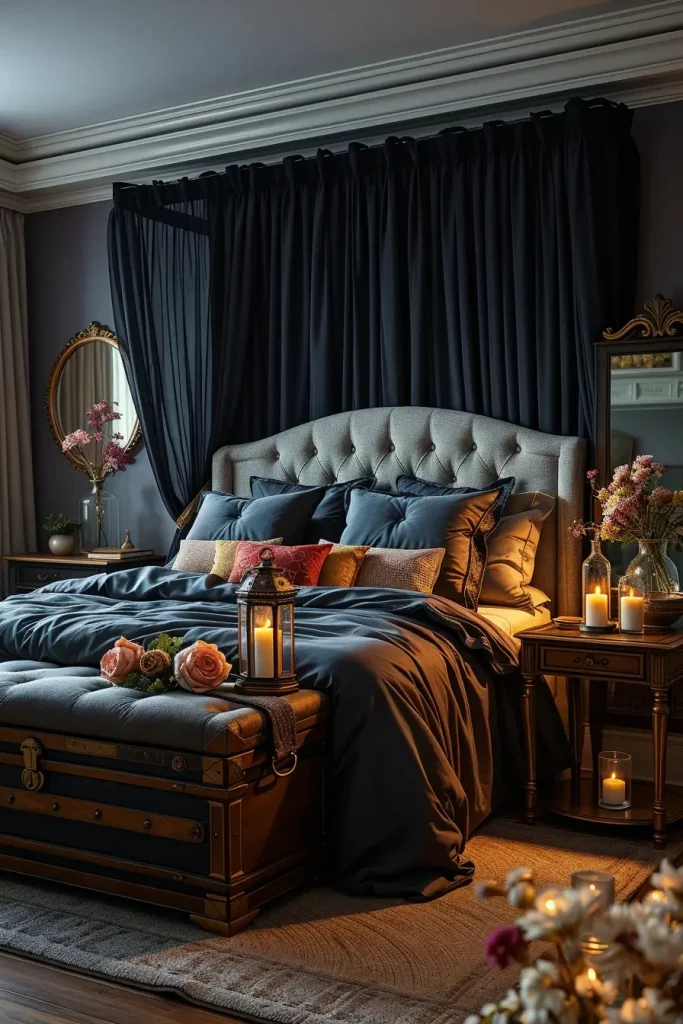
My position: bedrooms must continue to sleep well. Therefore I avoid fog, heavy scents, and strobe effects. Designers such as Athena Calderone talk a lot about restraint and material poetry, and I do the same here, focusing on the richness of materials versus plastic props.
I’d add blackout curtains in inky velvet (great for both darkness and drama) and a subtle wall projection (slow-moving branches or bats) on an ultra-low loop you can switch off with your phone.
Spooky Staircase Styling: Bats, Webs & LED Step Lighting
Staircases are vertical narratives. I cover the banister in gauzy black and weave micro LED string lights, and pile fake ravens at corners to lead the eye. I spread matte paper bats in a swirling gradient on the wall, small at the baseboard and oversized at the ceiling, to give an upwards movement.
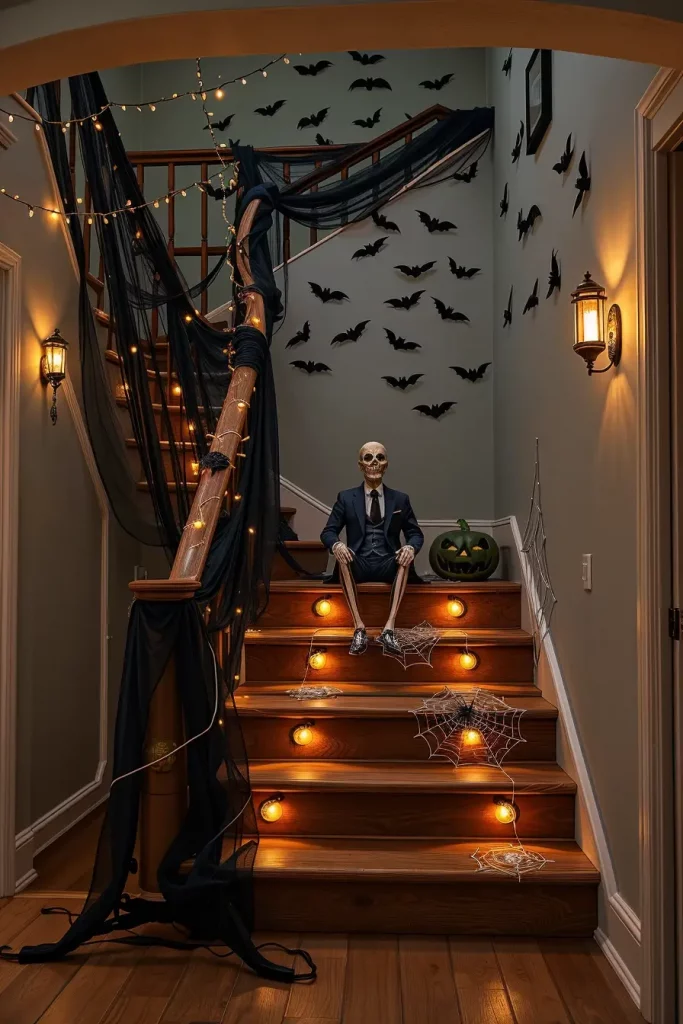
To be safe, I install LED step lighting or stick-on riser lights that are battery powered to maintain visibility. I put on removable spiderweb decals on the risers, black ribbon bows on the newel post, and a small motion-sensor sound module at the landing to give a soft crow caw or a distant thunderclap. If space allows, I place a single skeleton seated halfway up, elegantly dressed (blazer, pearls) for camp-chic humor.
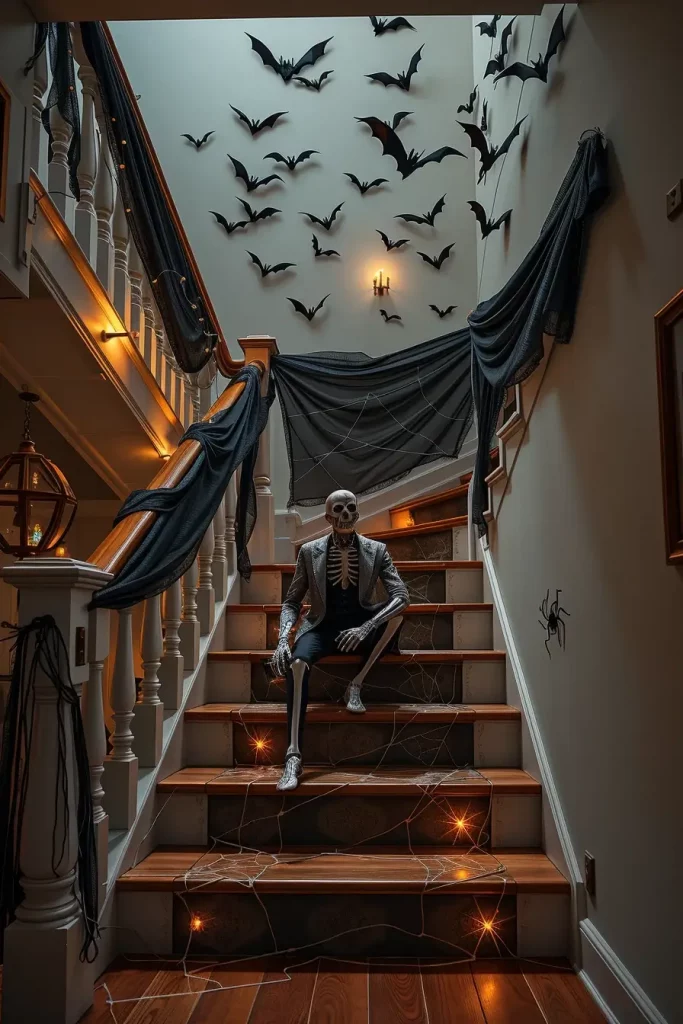
At work, I never compromise on code friendly lighting- no cords dragging on the floor, no tread obstructions. As most pro set decorators will tell you, anything that will cause a trip hazard should not be on stairs. I also test motion sensors during the day and at night so that no one is shocked into a stumble.
To take it to the next level, I would incorporate projection-mapped crawling shadows along the risers on guests arriving after dark, which is very effective, and surprisingly cheap in 2025.
Bewitching Entryway And Foyer Decor To Set The Tone
I approach the entrance as a movie trailer: it must set the tone of my Halloween decoration ideas 2025 at once, but remain practical, safe, and easy to revert to after the 31st. I start with layered, low, LED lighting (sconces dimmed warm, flameless tapers on a console) and a restrained color scheme that hints at what’s deeper inside—matte black, bone, and a single accent (rust, oxblood, or pewter). Since this is a high-traffic indoors area, I maintain the pathway clear and vertical: mirrors, art, and ceiling treatments do the heavy lifting and are not expensive, should I rely on peel-and-stick features.
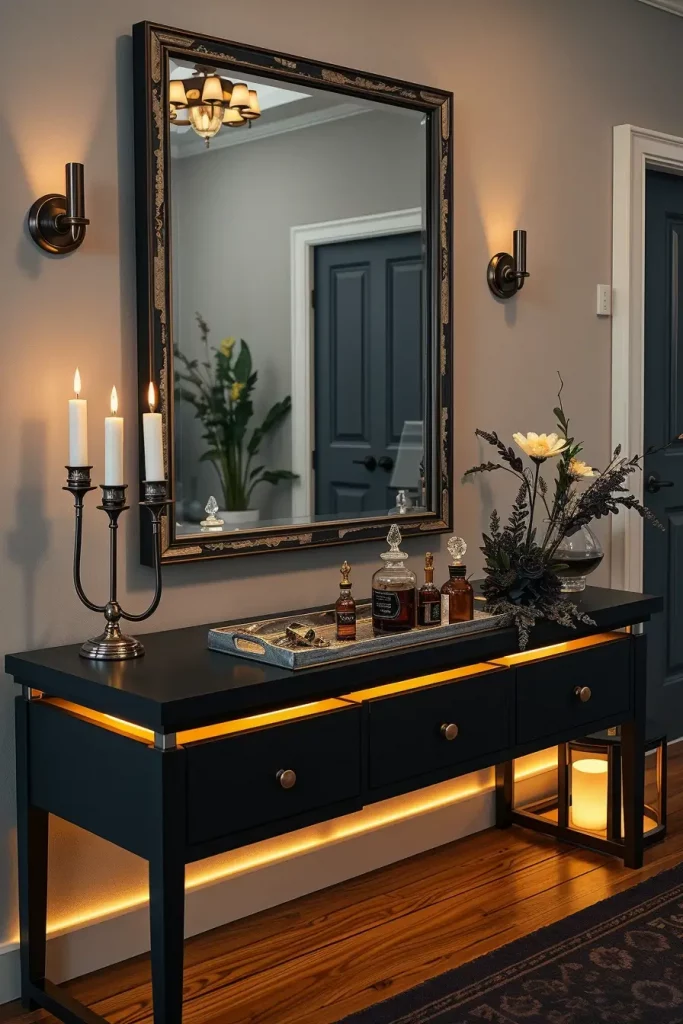
Item by item, I include a narrow black console with an antique silver tray of skeleton keys, apothecary bottles, and one cloche with dried blackened florals. There is a tall distressed mirror with candlelight and a motion-activated diffuser that emits cedar, clove, and smoke scents when the door is opened. I hang a narrow runner (dark, washable), swap standard lampshades for pleated black ones, and run a nearly invisible LED strip under the console edge for an ethereal glow.
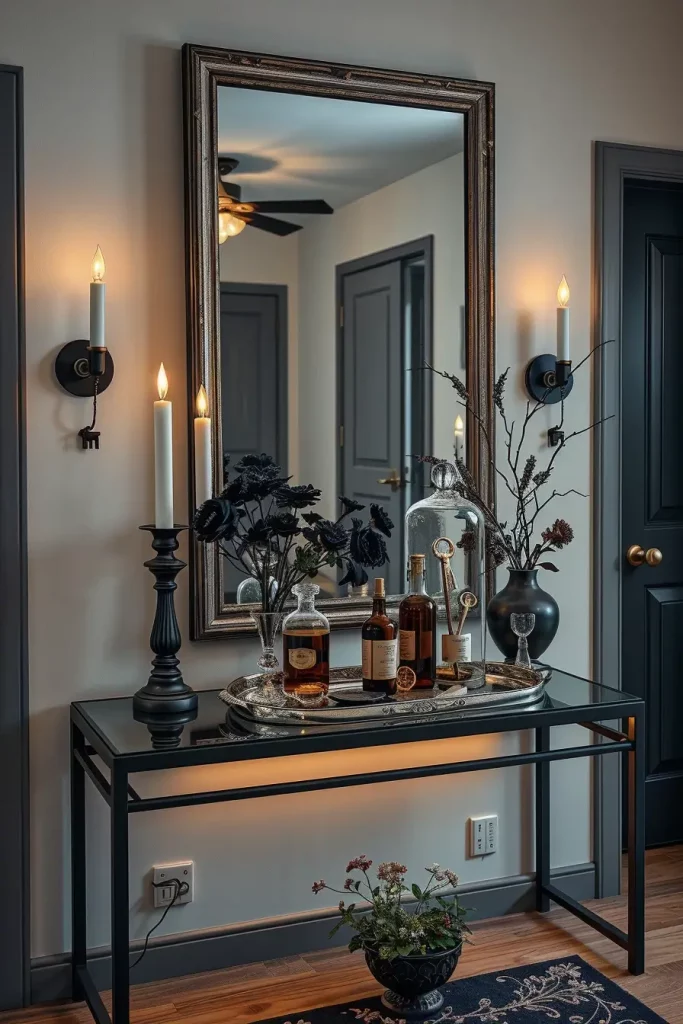
Sound, as well as light, is an asset to foyers: a hidden Bluetooth speaker can play some low-level wind-through-trees background; House Beautiful designers tend to emphasize layering of senses when it comes to seasonal decor, and I have found that to be particularly true in transitional areas. I also put labels on baskets with shoes, umbrellas, and candy so that the place does not turn into a mess on the night of the party.
What’s missing? I would include a small floating portrait digital frame that rotates through old-fashioned looking photographs that sometimes blink, which is subtle, playful, and very 2025.
Front Door And Porch Halloween Decor 2025: Wreaths, Skeletons & Projections
On the outside, I take chances since the porch is the advertisement of the entire house. In Halloween home decor ideas 2025, the game changers are projections and LED mapping: bats flapping on your siding, ghostly hands pushing on your door, or a spectral fog gate effect, looping around. I keep the layout symmetrical for impact—twin urns, twin lanterns—then break symmetry with one statement element (like a seated 8-foot skeleton reading a book).
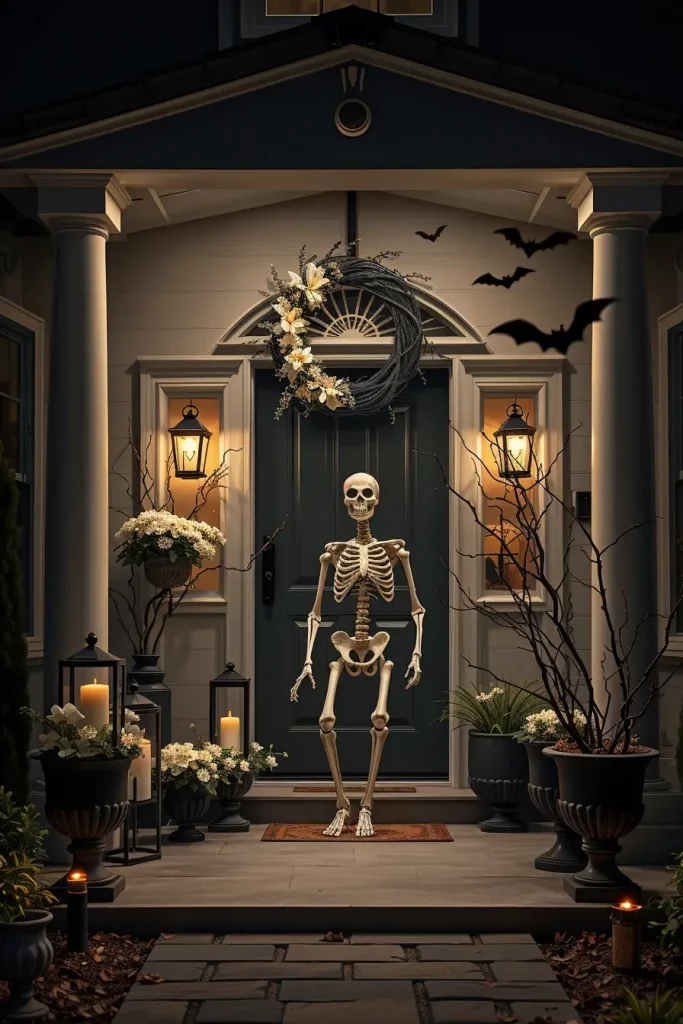
I have a matte-black wreath that has bone-white faux florals, torn velvet ribbon, and a tiny motion sensor to make it sound like a soft, low growl or whispers. On either side of the door: long lanterns with unlit candles, planter urns overflowing with blackened branches and low ground-level spotlights aimed upwards to add drama. A projection unit (weather-sheltered) bounces imagery onto the door or a scrim. Path lights (smart, color-shifting LED) guide guests safely to the threshold.
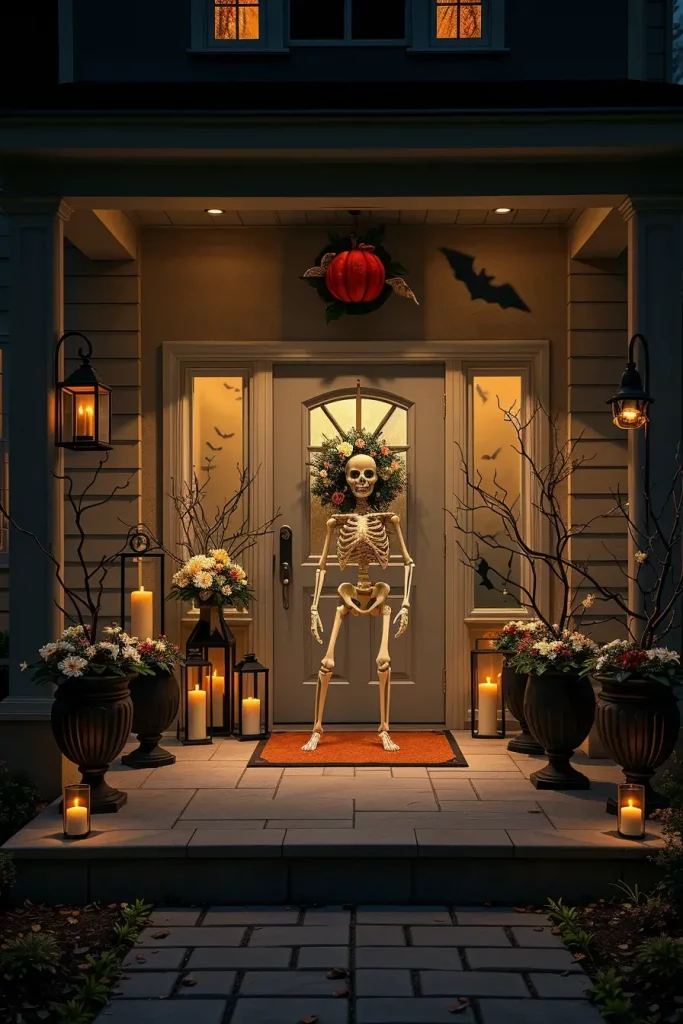
I tried out a lot of porch arrangements and discovered that the key is weatherproofing: zip ties, fishing line, and UV-resistant materials so your vignette does not sag by October 20. Decorating magazines such as Architectural Digest often warn decorators not to forget about showmanship and the wear and tear of outdoor decorations; I follow that advice by making sure I use heavy bases and all-weather cords.
To take it a step further, I would include a touch sensitive door knocker that would cause a skeletal hand to appear on the door panel- interactive, memorable and surprisingly inexpensive now.
Outdoor Yard And Garden Haunt: Path Lighting, Inflatables & Animatronics
I sculpt areas in the yard: a theatrical approach, a centerpiece graveyard, and a single moving surprise, preferably animatronics with sound and movement. To keep the design coherent (and budget-friendly), I stick to two or three dominant light colors (warm amber, moonlight blue, toxic green) and build layers using LED spotlights, lanterns, and rope lights tucked under shrubs.
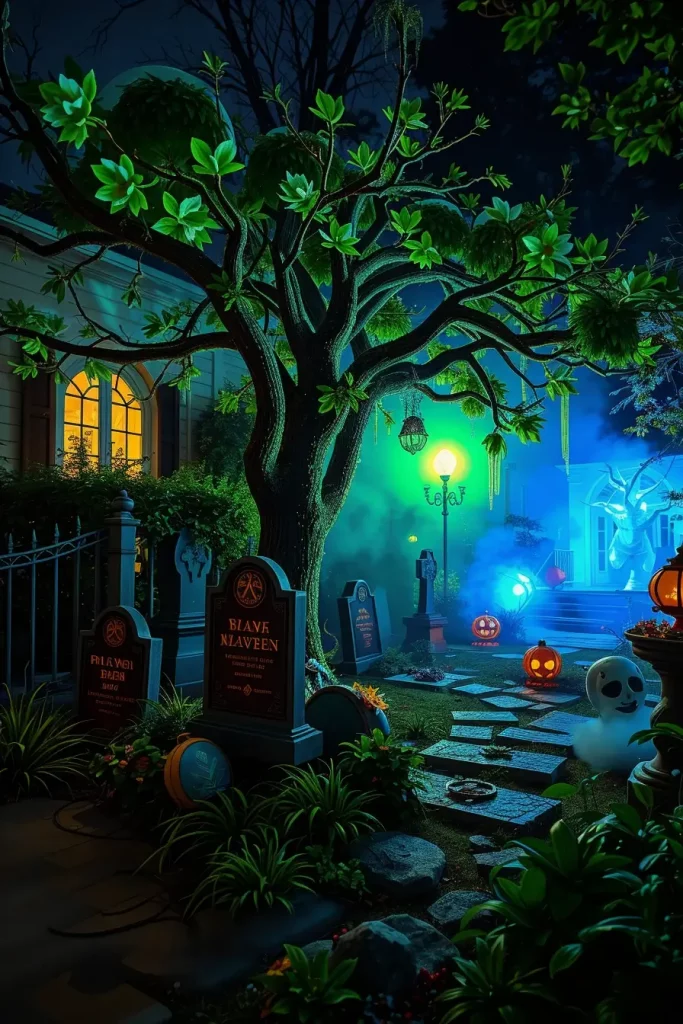
I stage foam tombstones in odd groupings, add low-lying ground fog (chilled for better pooling), and guide visitors through with stake LED path markers. Inflatables can look premium when curated: choose one large, high-contrast statement inflatable (like a towering spectral tree) and surround it with static props so it feels integrated. A scare beat is made by a motion-sensor crow or witch cackle halfway down the path; speakers located behind hedges distribute the sound in such a way that it cannot be localized.
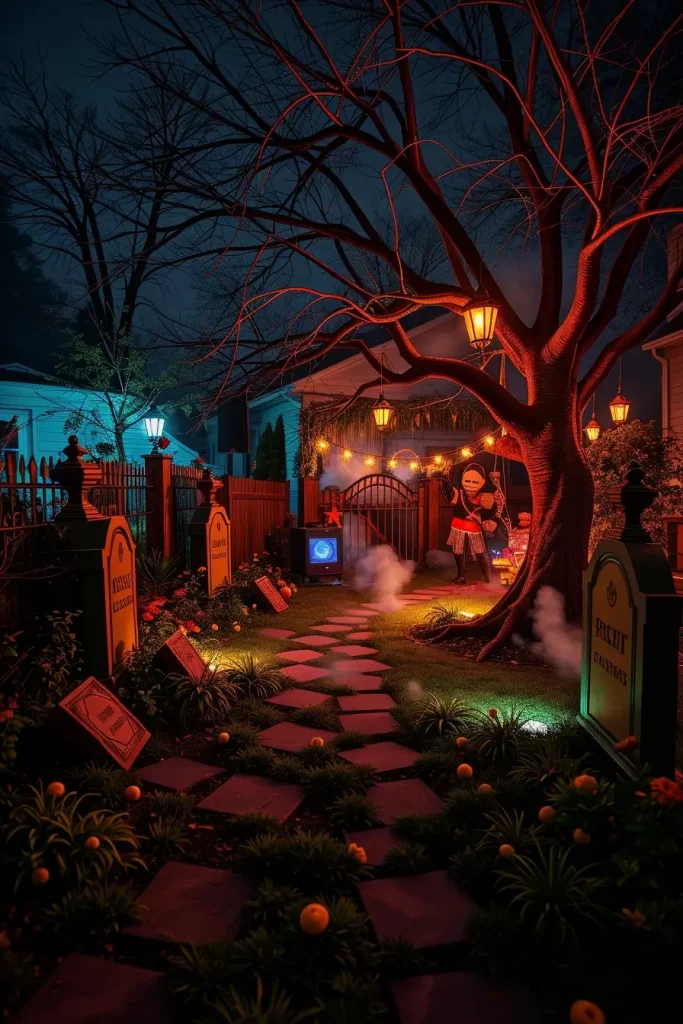
At the professional level, I never forget about power management: outdoor-rated extension cords, GFCI outlets, and cable covers throughout the paths. Most professionals suggest that you test your lights after dark at least two times to adjust intensity and color. In 2025, I am into app-controllable, low-voltage landscape systems that memorize scenes and schedules.
What’s missing? Ground illusions with projection mapping, such as the ground breaking into pieces or hands reaching up, are now consumer grade and definitely worth the slight learning curve.
Window Silhouettes, Decals And Shadow Plays For Maximum Impact
Windows are drama with high ROI particularly when you are in an apartment or need a large impact without a yard. I layer translucent scrims, LED backlighting, and cut silhouettes (witches, bats, wraiths) to produce crisp nighttime scenes. The secret: put the source of light behind your model, not in the window, to get deep, graphic shadows that people on the street can see.
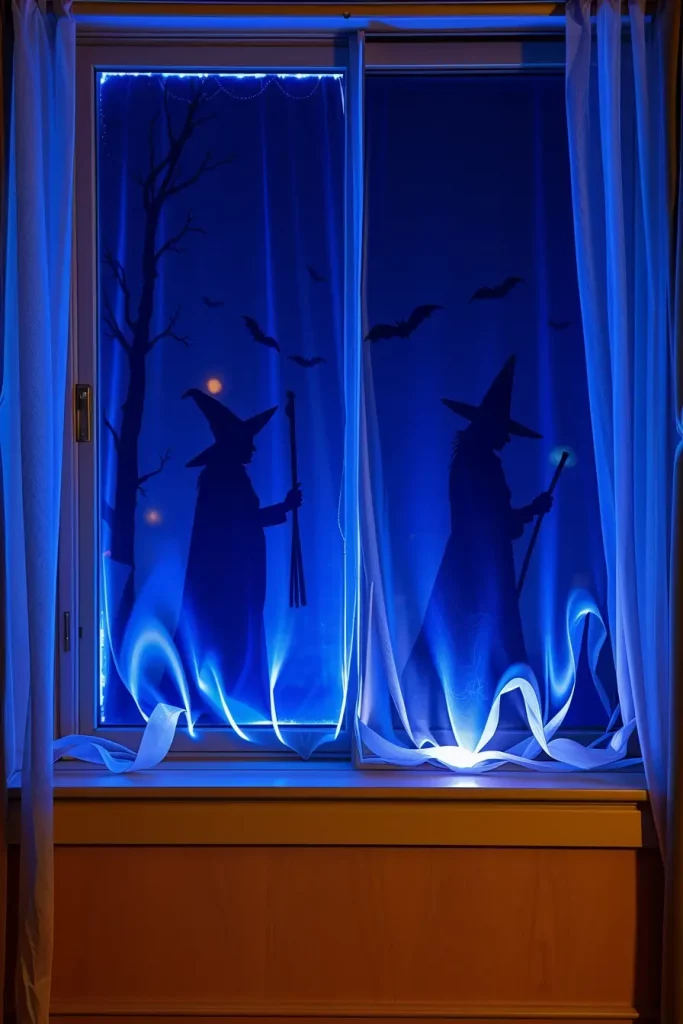
I start with blackout or sheer white panels depending on the vibe I want (void vs. spectral glow). Then I mount removable vinyl decals or cardstock cutouts, add a back row of smart bulbs (set to dim cool white or eerie blue), and experiment with small projectors to cast moving shadows—hands scraping, bats fluttering, branches swaying. I adore magnetic curtain rods and Command hooks so I can install them anywhere.
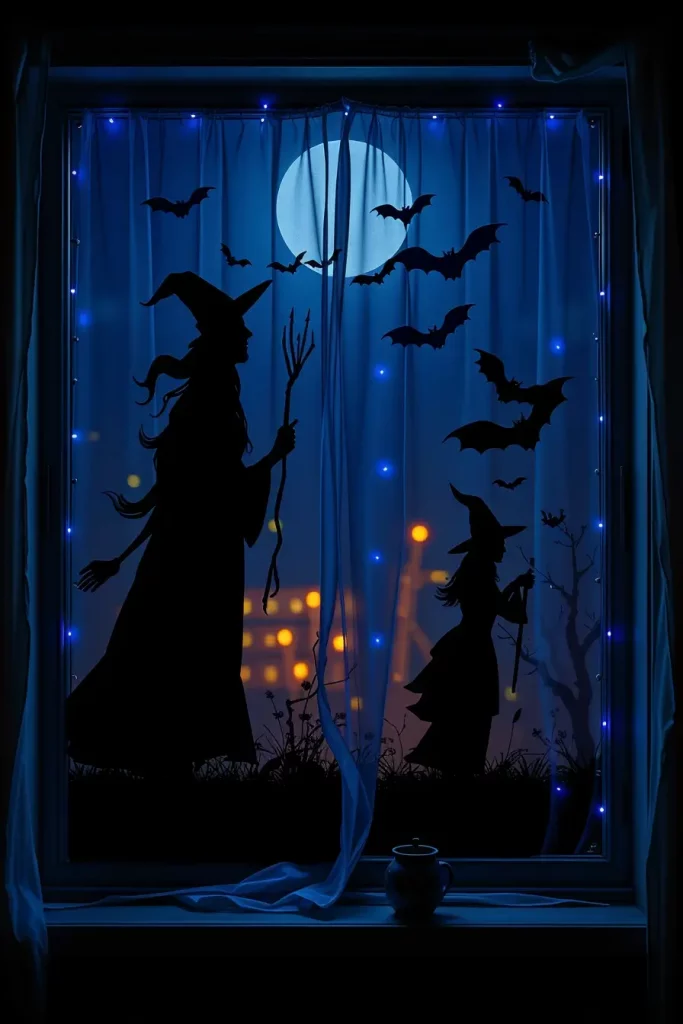
I’ve seen (and used) lightweight translucent films for “peering eyes” that only reveal themselves when lit from behind—fast, renter-safe, and striking. As numerous design blogs have pointed out, the effect of layering film, shadow and tint can be used to produce a cinematic effect at minimal expense; I have relied on this in small urban areas over the years.
To make it even better, I would introduce a lighting scene: warm and inviting at the beginning of the evening, then midnight-blue ghostly after 9 PM. It is subtle narration that can be felt by neighbors.
DIY Halloween Home Decor: Cheap, Fast And High-Impact Projects
Projects that provide scale are what I rely on when I need DIY speed: oversize paper bats, cheesecloth ghost veils, printable vintage labels on secondhand bottles, and black spray-painted branches. The secret to low cost impact is repetition-20 bats in graduated sizes will always win over one giant bat. and in 2025, you can light virtually anything intelligently with reactive LED strips and battery puck lights.
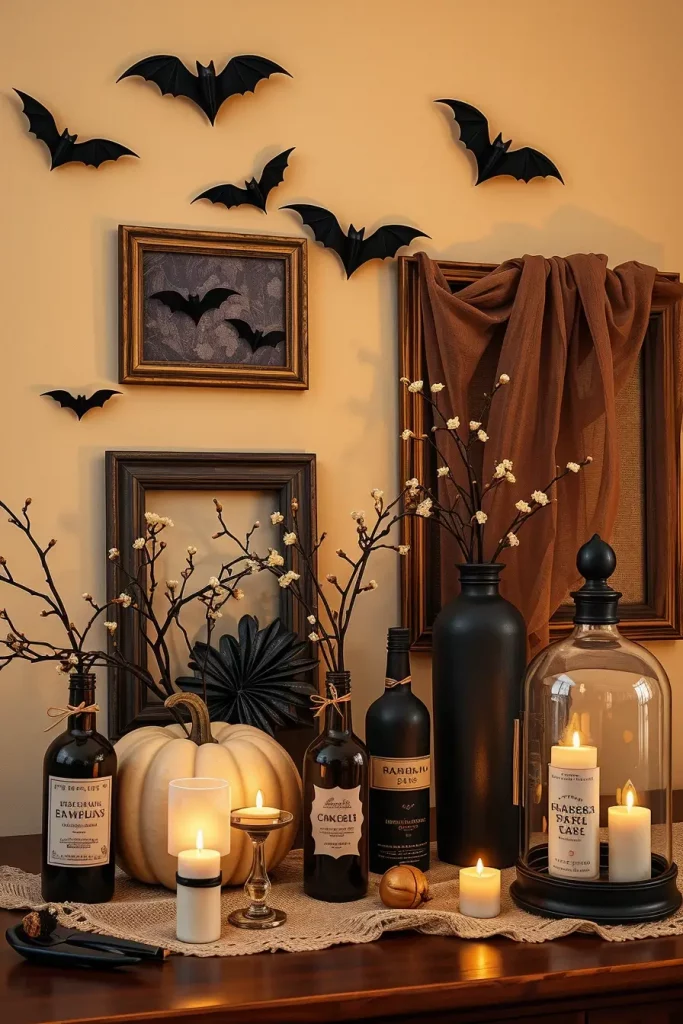
I am going to create a 10-minute gothic cloche: thrift-store dome, spray-painted base, dried florals and a mini skull on a riser. I’ll tear cheesecloth, dip it in black tea (or diluted black dye) for antique grunge, and drape it over frames and lamps. I will cover pool noodles with black fabric to make tall fake candles with hot-glue drips and put flicker LED tea lights inside.
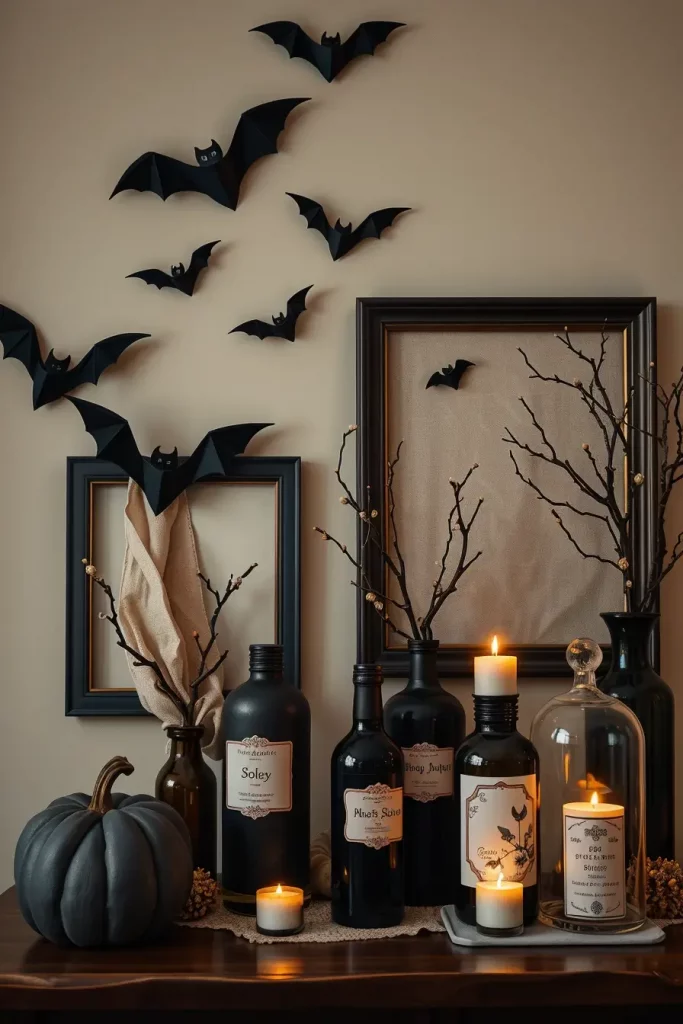
My rule: DIYs must be presentable during the daylight, so I do not use neon plastics and prefer matte finish. Other publications, such as Apartment Therapy and Remodelista, are always emphasizing materiality as the distinction between high and low, so I care more about finish than complexity.
Missing piece? A modular scent bar: thrifted amber bottles, essential oils (clove, cedar, smoke), and droppers so guests can “blend a potion” diffuser mix to take home. Affordable, unforgettable, interactive.
Dollar-Tree-To-Designer Hacks: Elevated Looks On A Tiny Budget
I love a Dollar Tree challenge: it is all about paint, scale, and grouping. To decorate the house with Halloween home decor ideas 2025, I take plastic skulls, foam pumpkins, thin candlesticks, glass vases, and fake flowers, and then I unify them with matte-black or stone-effect spray paint. All of a sudden, it is editorial, not bargain bin.
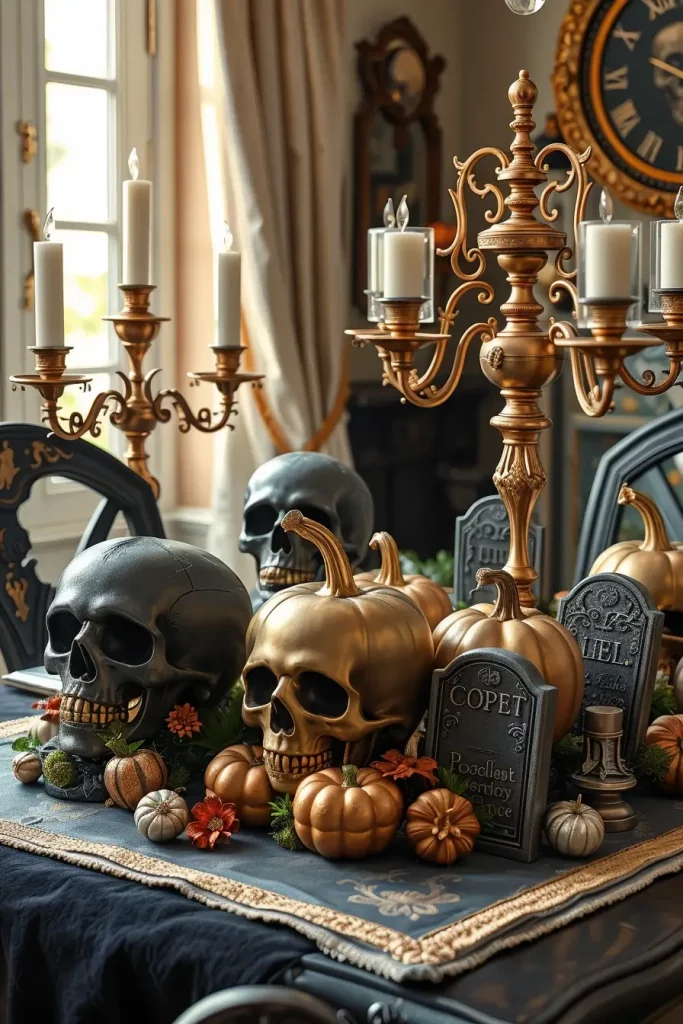
I group painted pumpkins in black and white piles, transform vases into faked antique apothecary jars with printable labels, and glue candlesticks into multi-armed candelabra and then cover the entire ensemble with satin black. Plastic frames are rubbed with rub n buff to look antique brass. Tea-stained cheesecloth is ethereal drapery. Even styro tombstones appear premium when dipped in gray primer, stone-texture spray and a mossy dry-brush.
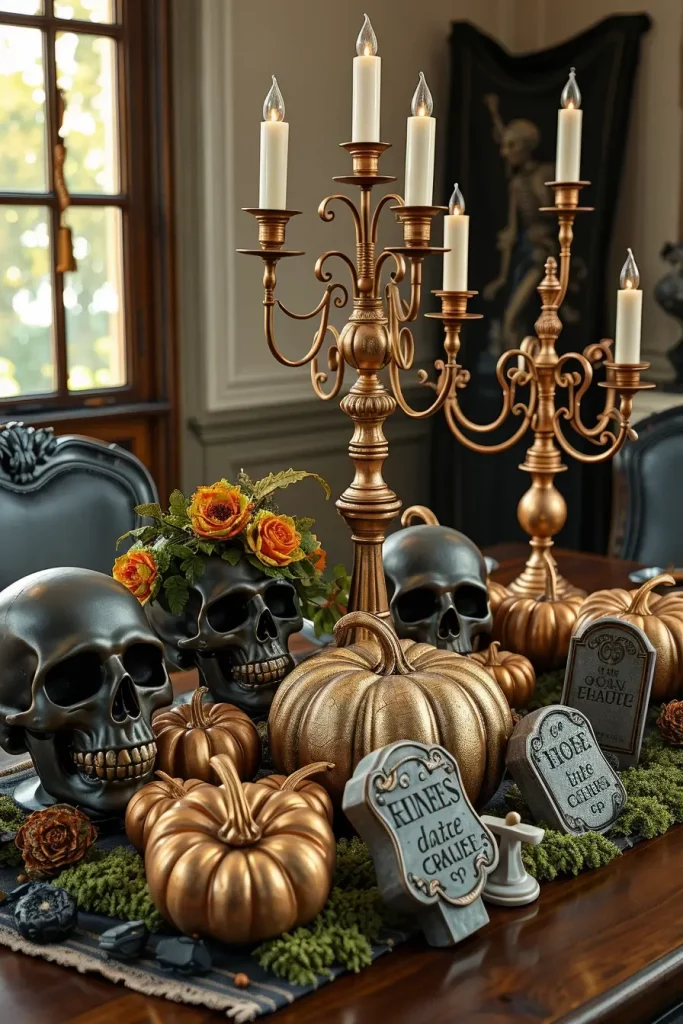
Experience teaches that it is all finish. Patina can be brilliantly simulated with paint, rub n buff and a light pass with a sandpaper. Most stylists suggest choosing one metal and sticking with it aged brass or pewter so the combination is not random. I am strict about that as far as cohesion is concerned.
What’s missing? A matte clear coat for longevity and texture sprays (concrete, stone, rust) to lift surface realism. Small investment, huge reward.
Kids-Friendly Halloween Home Decor: Cute, Safe And Interactive
When designing children, I focus on soft edges, low positioning and interactivity. I make the corner of the living room into a mini monster lab: felt bats, plush pumpkins, paper garlands, and pull-activated sound toys at kid height. LED all, no glass, and nothing tippy. The color scheme changes to lighter oranges, purples, and amiable greens, which are still united with the rest of the house but undoubtedly playful.
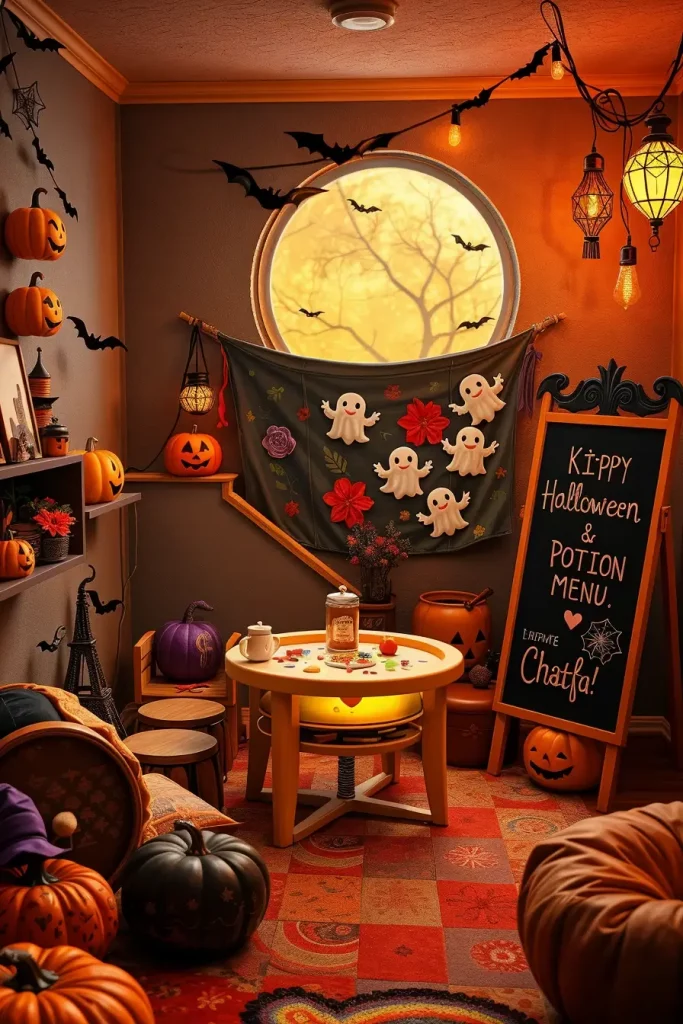
I love sensory bins (black beans, mini bones, rubber spiders), glow-in-the-dark wall decals, and motion-activated lights that sparkle instead of jump-scare. Hooks were used to hang felt masks so they could dress the skeleton. An art station is created with a chalkboard easel marked with Potion Menu. At bedtime I include a soft, low-glow projector with friendly ghosts floating lazily–soothing, not scary.
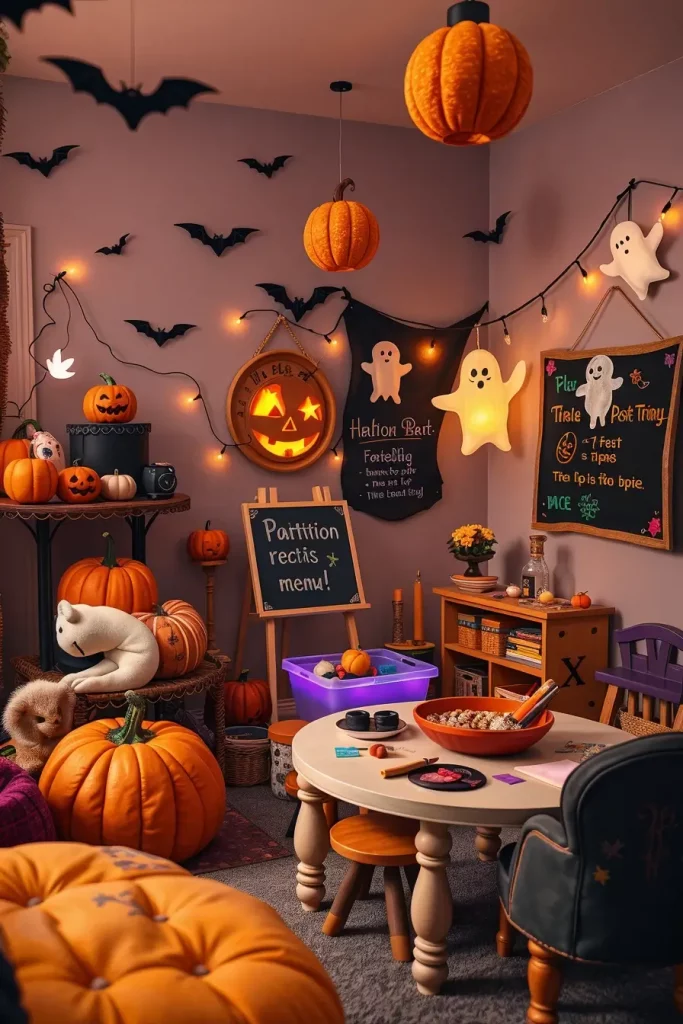
In my career I have discovered that labeled baskets and clear pathways save sanity- kids put decor back where it belongs. Parenting sites and pediatric suggestions focus on not having dangling cords and having battery compartments closed; I do both to the tee.
I would finish it with a trick-or-treat test route inside, taped arrows on the floor with small prizes at stations, so that little ones could train before the big night. Adorable, secure and confidence-giving.
Adults-Only Halloween Party Decor: Moody, Elegant And Theatrical
The adults-only areas are carefully theatrical: saturated black, oxblood velvets, smoked glass, and adjustable, layered lighting that makes everyone look good. To make Halloween decorations sophisticated, I begin by zoning the room, lounge, bar, and conversation corners, so the traffic helps in mixing and mingling. Texture is everything here: I pair matte plaster walls (or removable matte decals) with high-sheen lacquer trays and metallic taper candleholders to catch the light. This style will make the scene atmospheric and yet practical in serving drinks, moving around with ease and taking photos of the night.
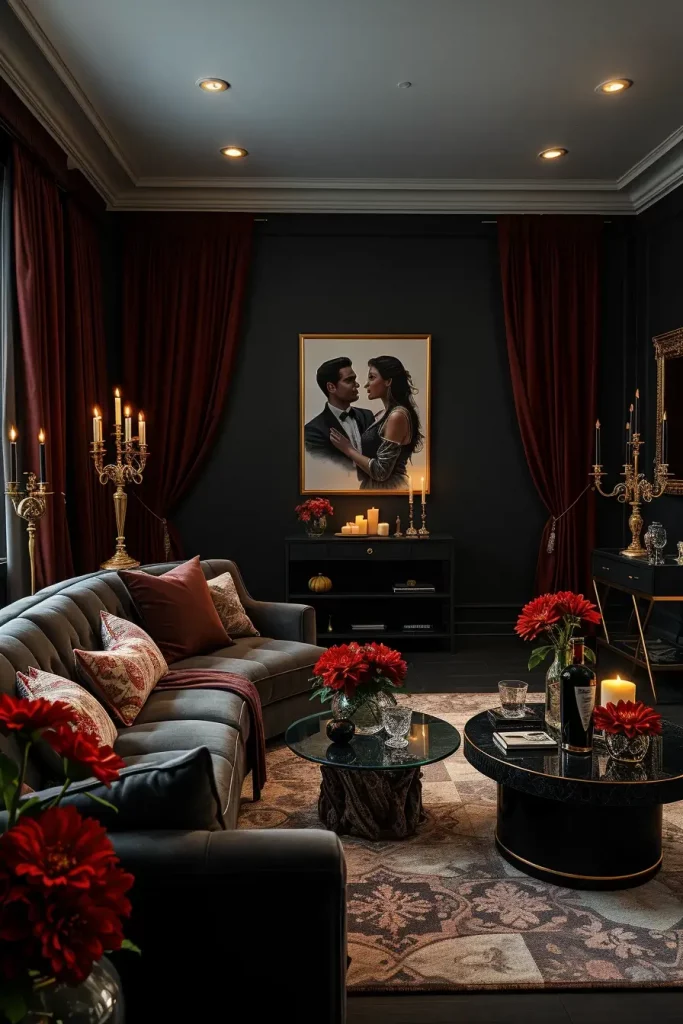
I will define a low, curved velvet sofa in charcoal, a marble or onyx-topped cocktail table, smoked acrylic bar cart, black tulle or voile drapery and antique brass candelabras with dripless black tapers. On the walls, I might hang temporary gothic-framed digital art (e-ink or digital frames) that loops archival horror illustrations. I will also include weighted velvet table runners, bone-china coupe glasses and hurricane vases with deep burgundy dahlias to maintain the palette and keep it upscale.
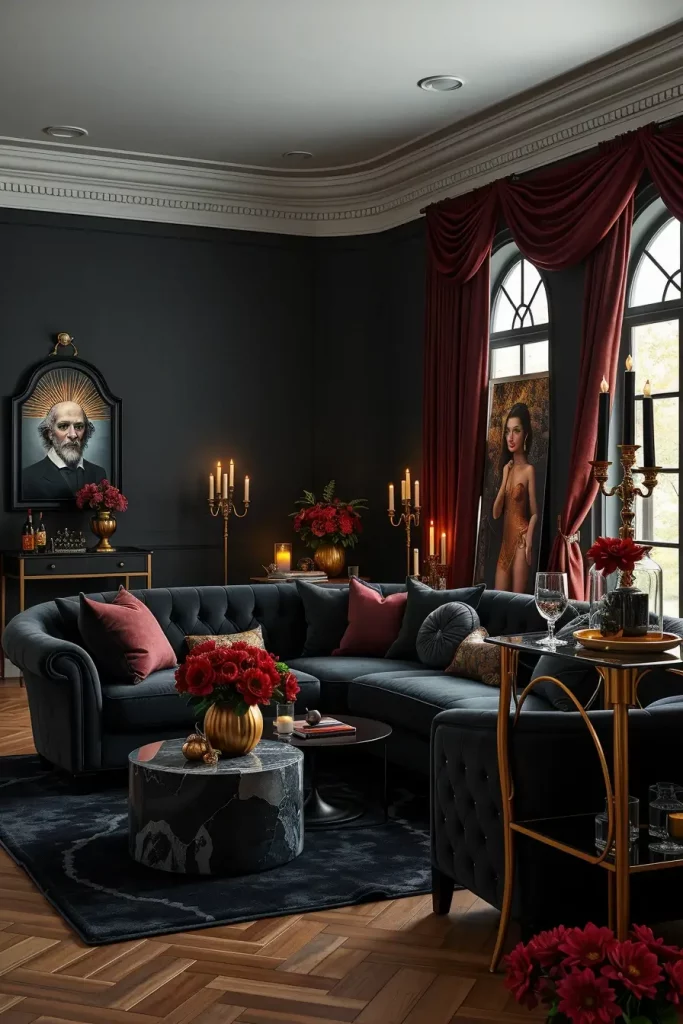
Personally, I’ve found that a 2700K (or warmer) dim setting on smart bulbs gives the best “theatrical” glow without turning faces orange. Layered lighting is the quickest trick to make it dimensional, as Architectural Digest always points out; I concur–and I never leave out tiny battery-powered pin spots to illuminate florals or sculptural ornamentation.
What I would still include: velvet rope or gauzy partitions to divide the bar space in a tasteful manner, and a discreet coat-and-mask check so the look is not polluted by outerwear. And yes, a playlist curated to match the moody vibe (think dark synth, slow jazz) completes the sensory experience I’m after.
Color-Forward Palettes: Neon Slime Green, Toxic Purple And Blood Orange
When I feel like I want a look that says 2025, I go into the hyper-saturated neons neon slime green, toxic purple, blood orange, with a balance of matte black grounding elements. This is where Halloween home decor ideas 2025 is shamelessly loud. I will apply these colors in gradients on textiles, smart LED strips, acrylic accents to make the palette sing instead of colliding. The key: keep your big furnishings neutral (black, white, gray) and let color live in light, art, and accents.
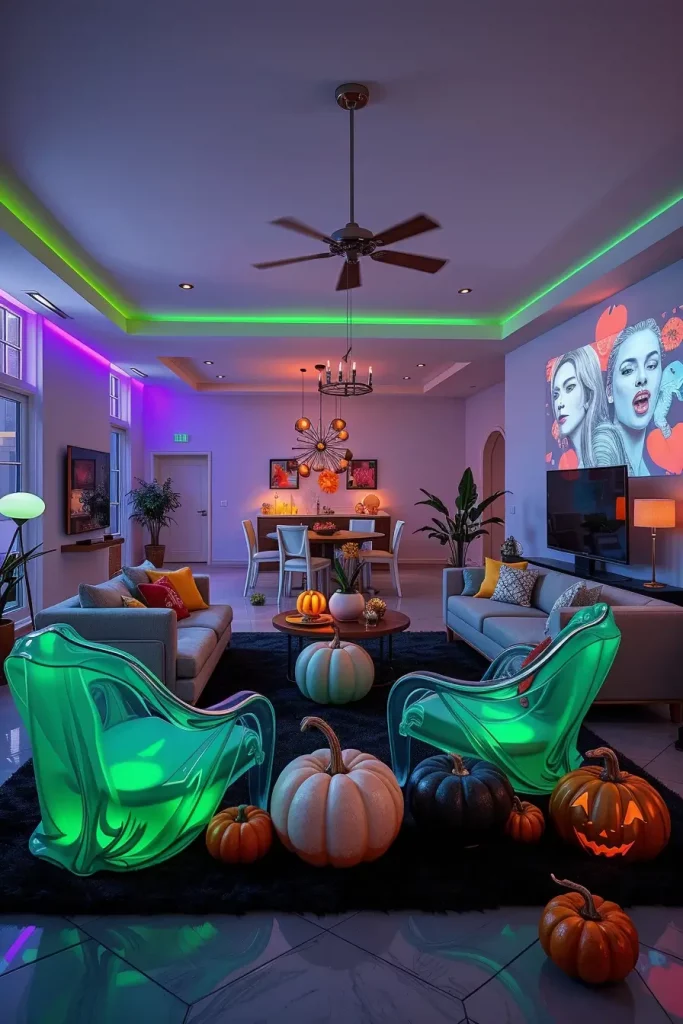
I add modular LED tube lights, color-changable smart bulbs, neon-acrylic coasters, lacquer trays, glossy painted pumpkins in ombr e gradients, and acrylic ghost chairs that allow light to pass through. The space is anchored by a black area rug, and three-neon triad is repeated by throw pillows and blankets to create consistency. An interior RGB lit matte black bar cabinet is an instant show piece.
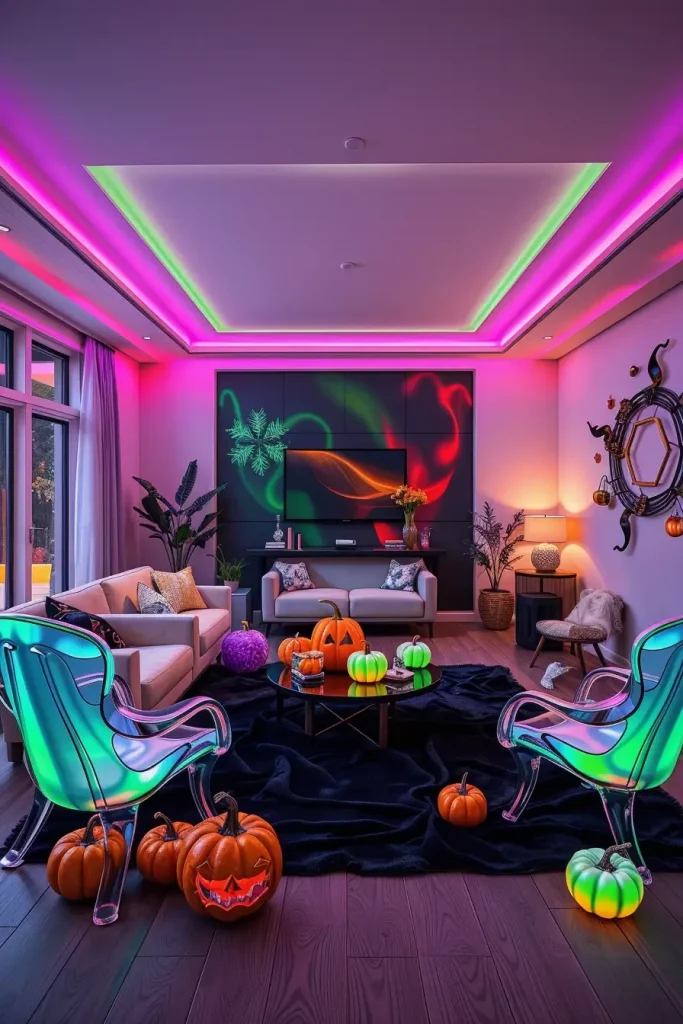
Personally, I would recommend giving each color a certain area to rest your eyes e.g. green entry, purple lounge, orange tablescape etc. Emily Henderson also suggests using powerful grounding neutrals to manage saturation; it is a rule I triple down on when I create these spicy palettes.
I’d still add: a projection of animated color washes on a wall or ceiling to tie the triad together, and a “color legend” card on the bar explaining signature cocktails mapped to each neon tone (fun, and keeps the palette narrative tight).
Minimalist Black-And-White Halloween Aesthetic: Sleek And Chic
To clients who despise visual clutter, I create a black-and-white Halloween that is sculptural, graphic and serene. I use silhouette shapes, high contrast wall decals and negative space. This is where the fans of minimalism can still enjoy Halloween home decor without ruining their style. I’ll paint (or cover) one accent wall in deep black and layer white matte ceramic pumpkins, bone-white taper candles, and thin-line black metal lanterns.
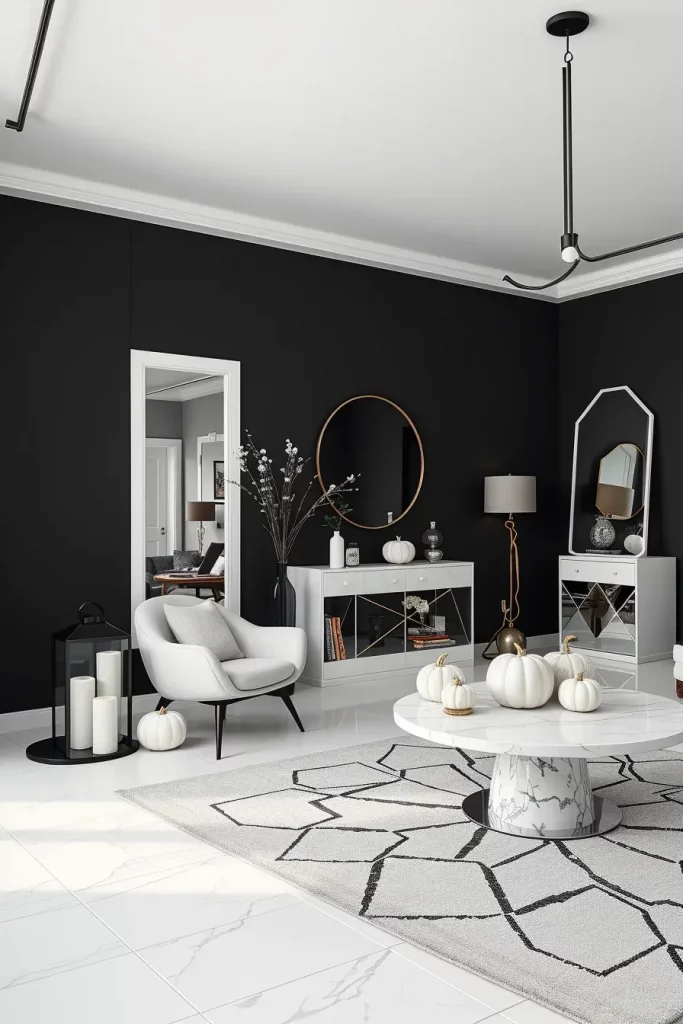
Furniture is scaled down: low profile black sofa, white boucle accent chair, thin marble pedestal table, black and white geometric rug and frameless mirrors to reflect light. I will include some simple black branches in white vases, graphite-coloured smoke glass votives, and white plaster skulls on black plinths to bring some sculptural impact. The styling rule: there should be only one big statement on each surface, not numerous little things.
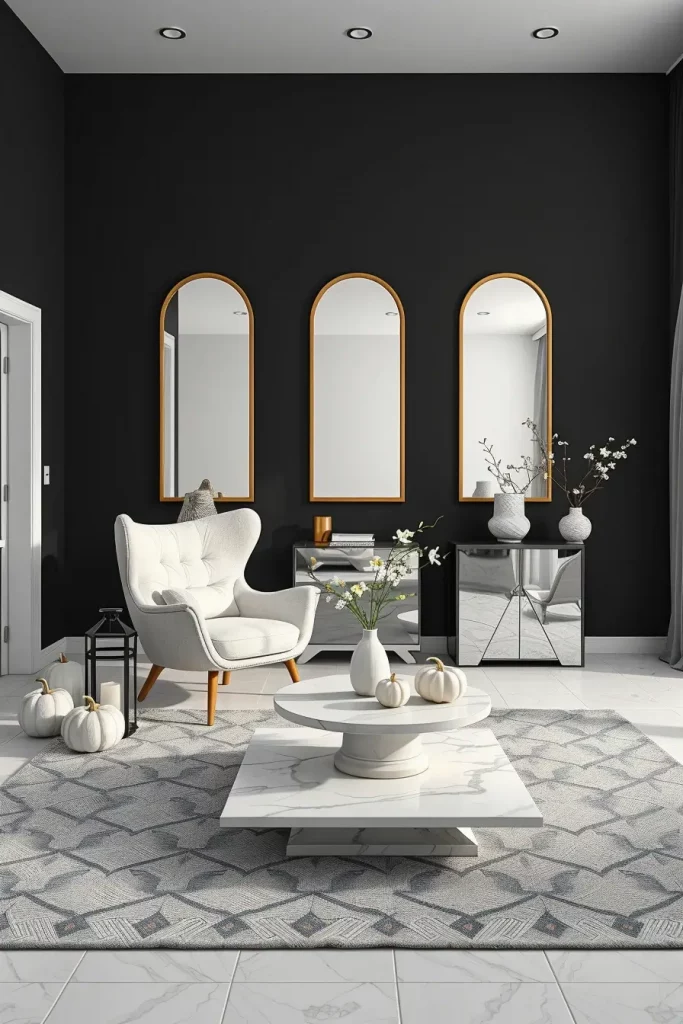
I have also come to understand that black matte finishes appear more expensive and less plastic Halloween store. As Studio McGee often highlights, restraint can magnify impact—so I set a strict black/white rule with one metallic (brushed nickel or aged brass) to keep everything cohesive.
I would still include: one, large, abstract black and white painting or a removable black decal on the ceiling to make the ceiling seem lower and the atmosphere more intense.
Vintage And Retro Halloween Accents: Nostalgia Meets Modern Styling
I adore pairing vintage die-cut paper cat, 1930s inspired pumpkin lanterns, and mid-century blow molds with modern furniture, so that the overall effect is fun rather than tacky. I fill it with tight, purposeful vignettes to avoid it looking like a flea market: a glass-front cabinet, a lone bookshelf, or on a console, with a modern lamp and a clean runner.
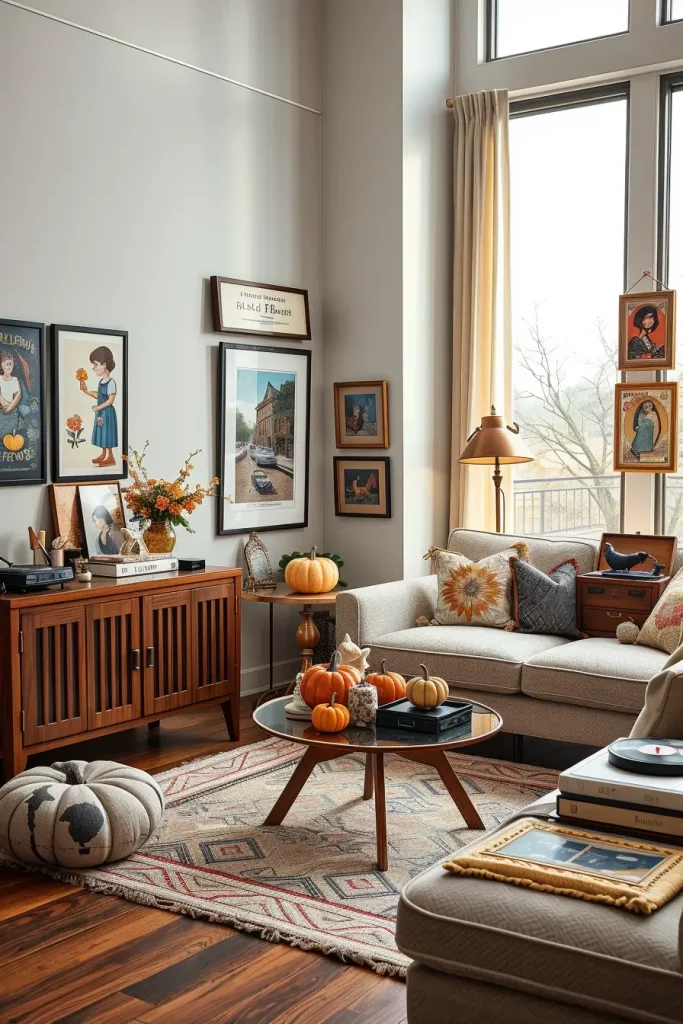
I will mix a walnut credenza, a boucle or channel-tufted sofa, a brass pharmacy floor lamp, and a patterned wool rug with selected retro items: papier-mache pumpkins, tin noise-makers, early-1900s postcard prints in thin black frames, and Bakelite-inspired orange trays. The retro angle is subtly supported by a record player playing creepy old time jazz or theremin music.
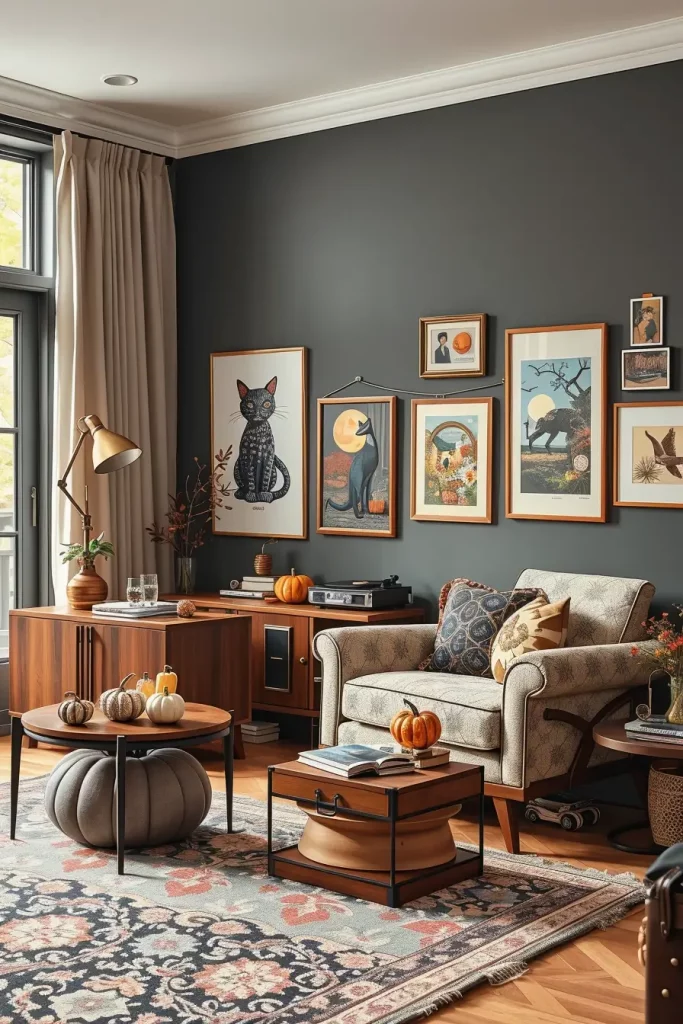
From experience, it’s best to limit yourself to two or three decades (say, 1930s and 1970s) so the story reads clearly. A lot of House Beautiful dealers and editors stress editing collections- show less, but better grouped. I definitely concur; curating makes nostalgia less cluttered.
So what is lacking? A special shadow box to hold delicate ephemera and museum putty to hold fragile items–very handy and necessary when you are hosting.
Witchcore 2025: Herbs, Spell Books And Crystal Displays At Home
Witchcore 2025 is gentler, more natural, and more academic-looking, i.e. apothecary cabinets, labeled amber bottles, dried herb bundles, and illuminated crystal shelves, but in a modern house that people can live in. I set the tone with earthy plaster walls (or removable limewash-look wallpaper), dark wood furniture, iron candle stands, and botanical prints. It is mystical and not theatrical.
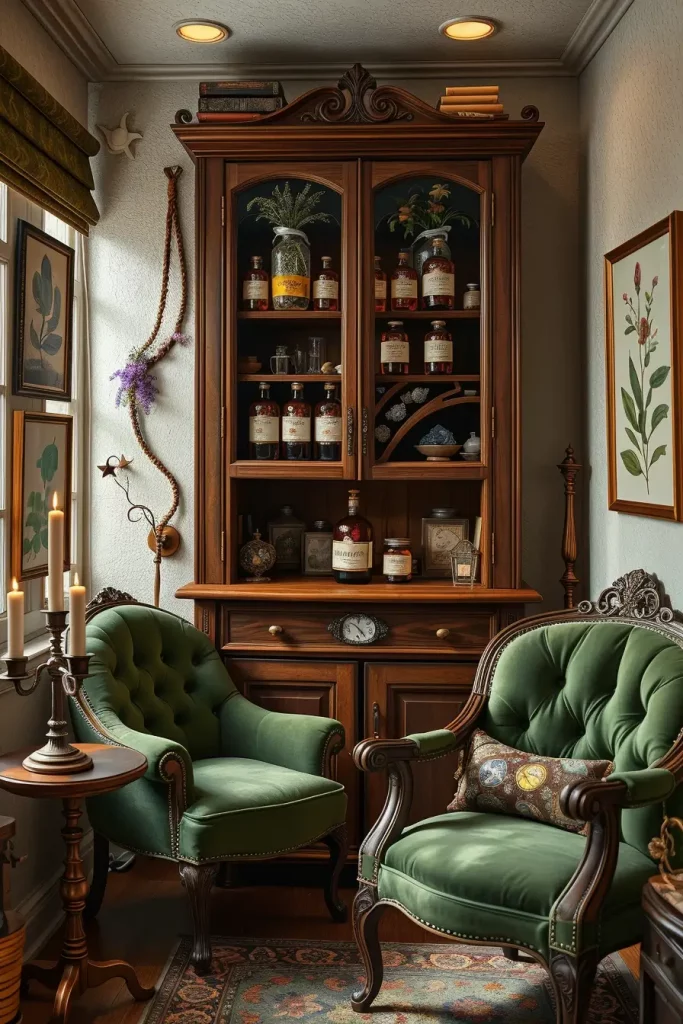
I am precise about a glass-door apothecary cabinet, marble mortar and pestles, brass balance scales, black taper candles in iron holders, ethically sourced crystals on walnut shelves, and linen-covered vintage books. The vibe is finished off with a mossy green velvet chair in front of a small reading table and an oil diffuser with vetiver or cedar. It is intimate with low warm lighting.
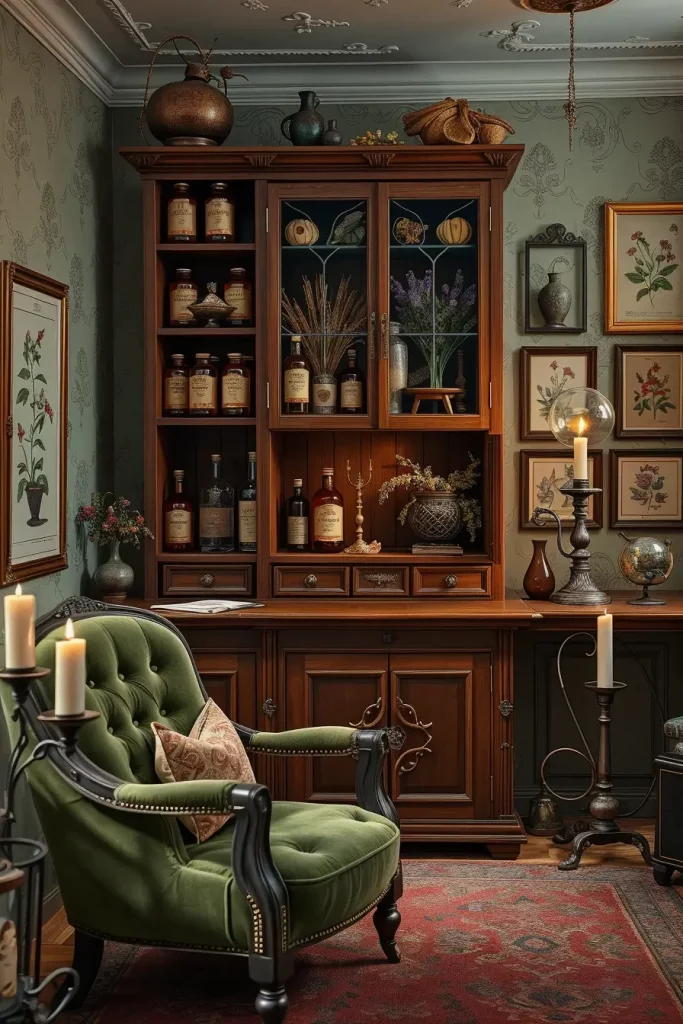
On a personal level, I keep clutter to a minimum by labeling everything in a neat manner and by color or mineral family. As Sarah Richardson is fond of saying, disciplined organization is the difference between curated and messy, even in maximalist directions such as witchcore.
I’d still add: an LED-backlit crystal shelf (with adjustable warmth) and a discreet storage drawer for tools you don’t want on display, like cords, incense, or ritual accessories.
Pumpkin Styling Beyond Jack-O’-Lanterns: Painted, Carved And 3D-Printed
Pumpkins are a design medium in 2025: matte spray-painted, laser-etched, CNC-carved, resin-cast, or even 3D-printed. I apply them to repeat the palette or texture narrative of a room: painted pumpkins with the terrazzo-speckle, faux-concrete finishes, pearlescent whites, or neon gradients to the color-forward home. They are sculptural, stackable and reusable when you go faux.
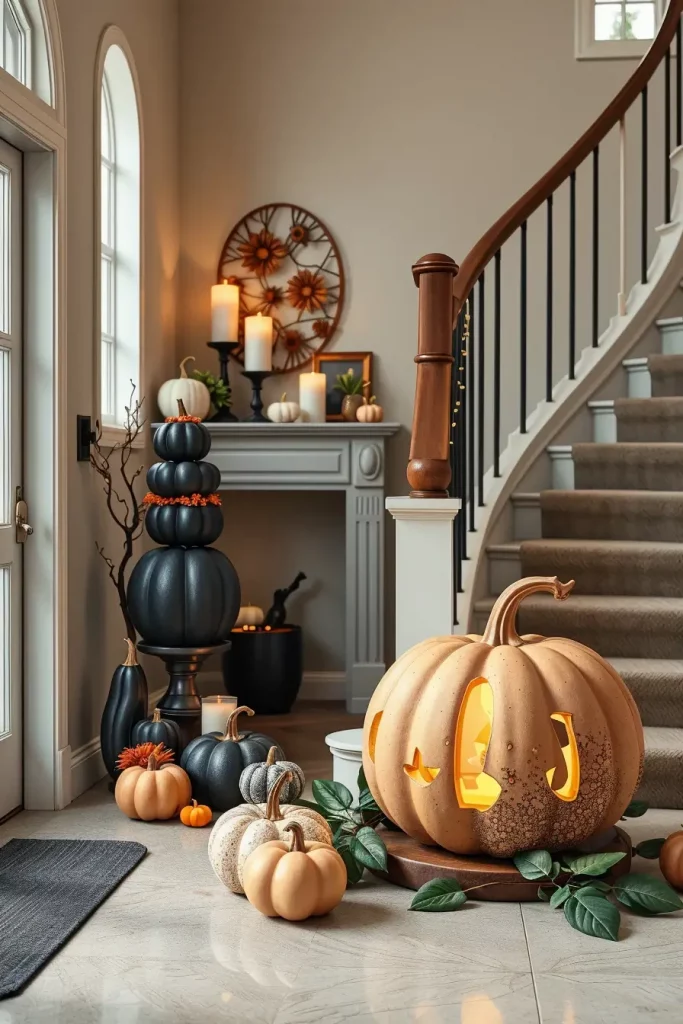
I will set up a pumpkin totem on a stair landing, set micro 3D-printed gourds along a mantle, and group large matte black pumpkins at the entry with LED pillar candles. Hollowed faux pumpkins make my favorite vases on dining tables filled with dahlias, amaranthus and black foliage. To be long lasting, I prefer foam or resin pumpkins, which accept paint and are lightweight.
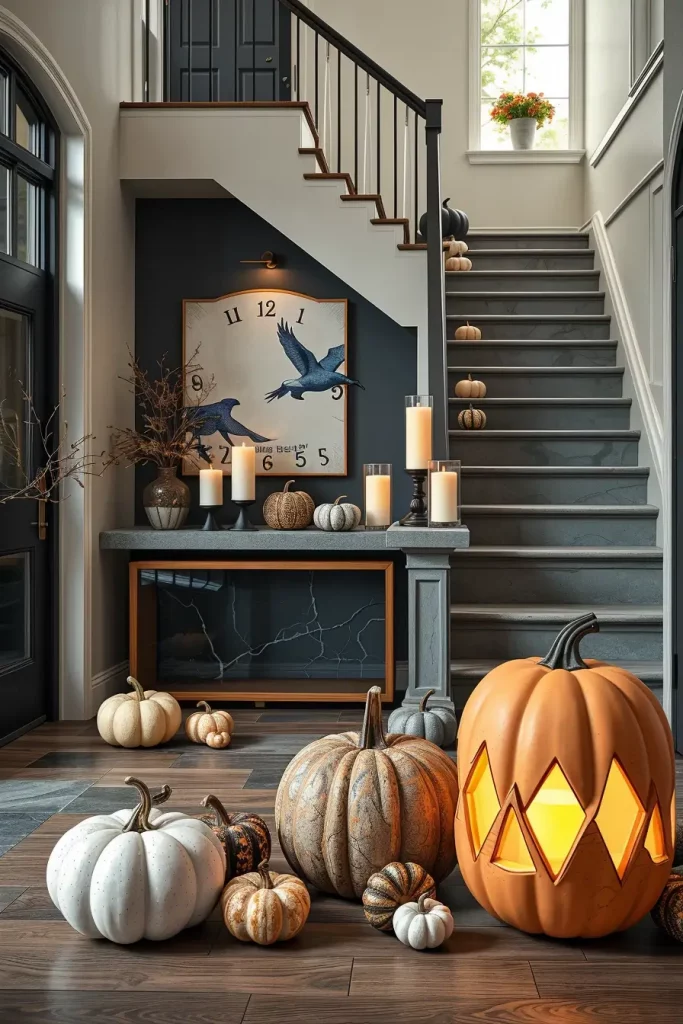
I’ve learned to seal all painted pumpkins with a matte topcoat to prevent chipping (especially if you’re reusing them). Prep and sealing are 80 percent of the quality of the finish, as the DIY experts at HGTV are fond of saying, and I take them as such.
I would still include: one pumpkin of the hero type with laser-cut patterns and an internal smart bulb that gradually changes the warmth to produce motion without strobe effects.
Skeleton Scenes And Poseable Props: From Comic To Creepy
The most pliable decor actor of 2025 is poseable skeletons: sitting at pianos, serving cocktail bars, reading in libraries, or climbing bookshelves. It is not only the figure that should be stylized. I place mine in realistic vignettes using task lighting, props and a consistent color scheme so it seems deliberate- comic, creepy or both.
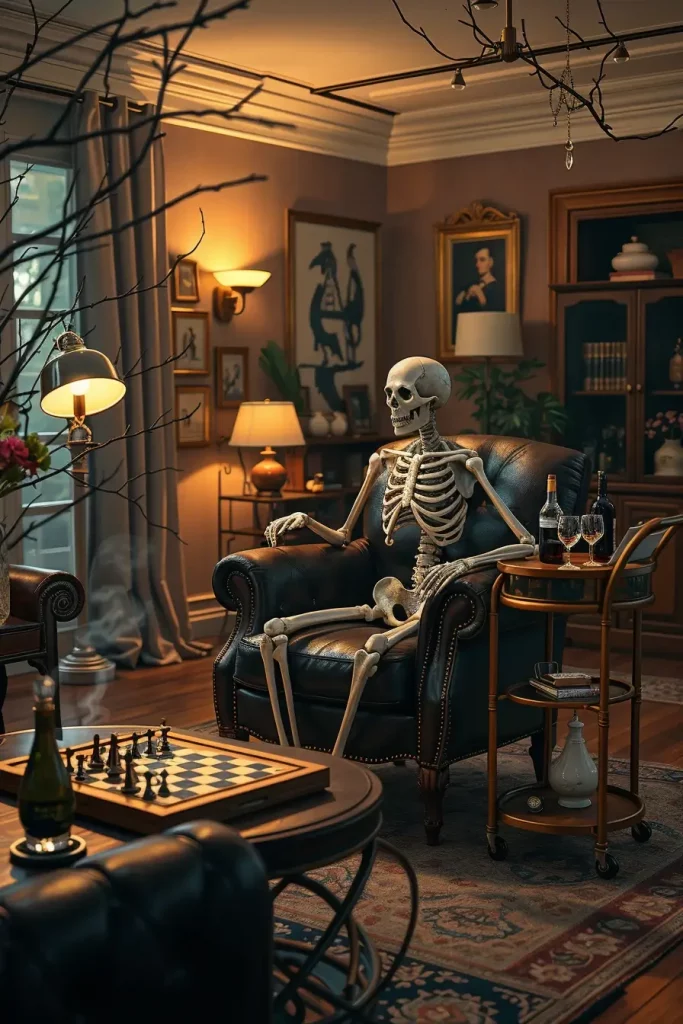
I will place a bentwood or leather lounge chair, an old fashioned bar cart, reading glasses, piles of books, a pipe, sheet music or a chessboard to give the skeleton a plausible purpose. To get creepier scenes, I switch to low, directional light, smoke, torn cheesecloth, and black branches. A funny, graphic installation is made of wall-mounted shelves with mini skeletons in the same poses.
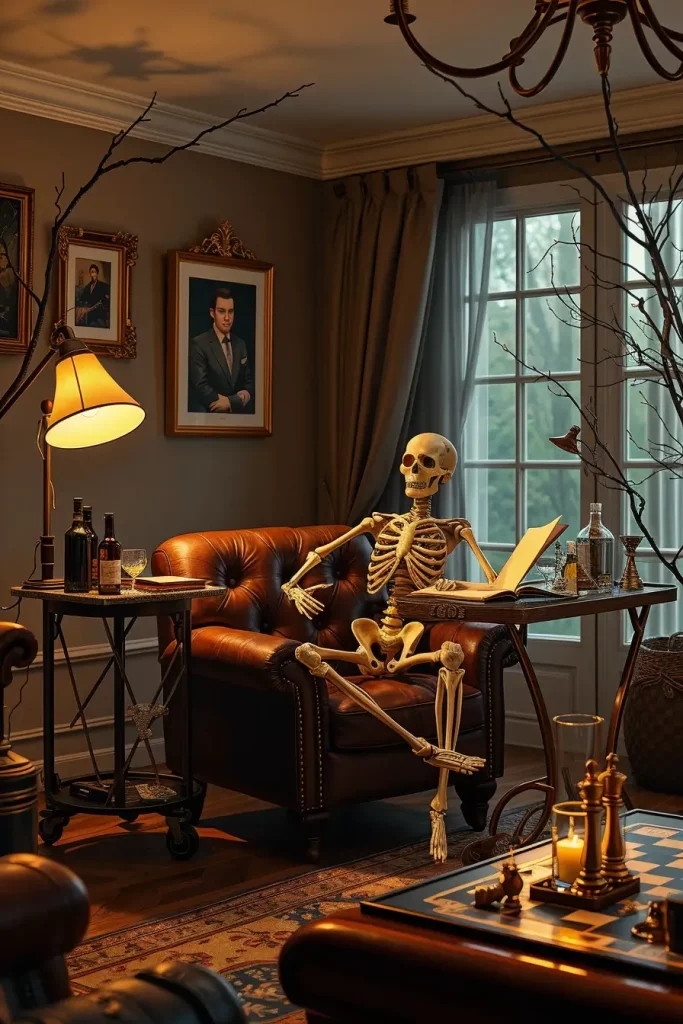
From practice, I secure joints with clear fishing line or wire for safety and symmetry (nothing kills the scene like a slumped skeleton halfway through the party). Many stylists recommend lighting props (like a mini lamp on a console) to make skeletons feel “alive” in the space—this works every time.
I would still include: a QR code around the area that leads to a themed playlist or AR filter that covers ghostly movement on scan- physical and digital merged together to entertain the guests.
Mantel, Shelf And Console Table Vignettes: Layering For Depth
When I construct Halloween vignettes on a mantel or console, I plan in three planes: a dark, plain background; a sculptural middle-ground; and a few delicate, high-contrast elements at the extreme foreground. I’ll paint or temporarily wrap the mantel back wall with peel-and-stick matte charcoal, stand up tall silhouettes (bats, bare branches, or gothic arches), and then weave in reflective surfaces (antique mirrors, mercury glass, black chrome) to bounce candlelight.
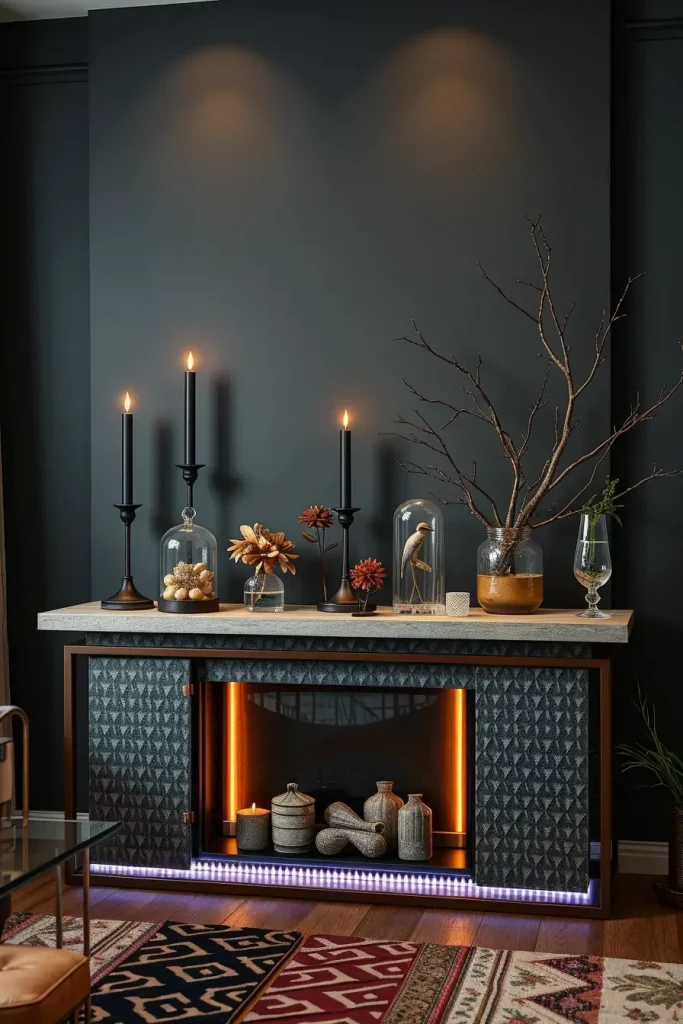
I specify black taper candles in mixed heights, cloches over tiny “specimens,” ceramic pumpkins in stone or concrete finishes (they feel modern and more sustainable than plastics), and a thin smart lighting LED strip tucked under the mantel lip to lift everything with a dim, programmable glow. I will use a velvet runner, bone-colored bead garlands, and a pile of occult-looking coffee-table books on a console to take the palette beyond orange-and-black basics.
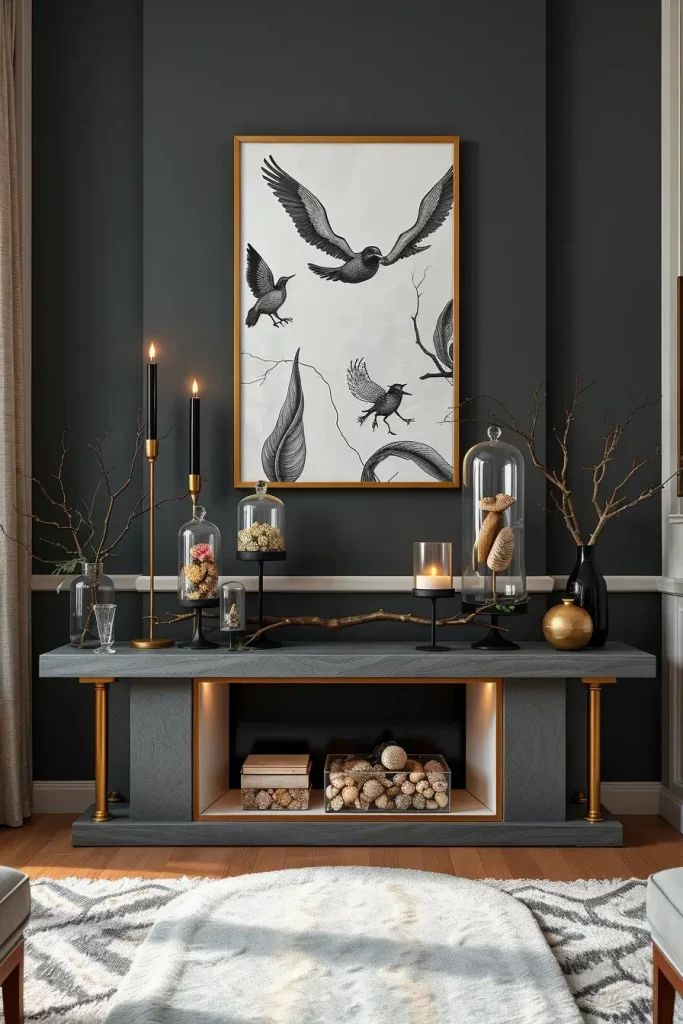
The secret is to balance matte and shine, as experience has shown. Too shiny and it looks like a costume-store, too matte and it looks flat. House Beautiful has repeatedly mentioned how even the slightest flashes of chrome or glass can make even the so-called dark palettes luxurious, and I believe that it is the same case here. And no symmetry, either–Halloween looks best asymmetrical, and one tall branch or bust drawing the eye.
Missing? Height variation. I’d add risers (hidden blocks or stacked books under cloth), one oversized sculptural object (a statement bust or urn), and maybe a low, quiet soundtrack hidden in the console to make the vignette feel alive when guests approach.
Halloween Tablescapes And Centerpieces: Floral, Candlelight And Texture
In 2025 I am going full moody deconstructed botanicals, dried blackened hydrangeas, burgundy dahlias, dusty eucalyptus, and trailing amaranthus, low and sprawling so that people can still see each other. I prefer a raw linen or black washed cotton tablecloth overlaid with frayed gauze runners, to give a contrast of texture. Candlelight? Always. I placed a grid of low votives with varying pillar heights so the general light is not blinding but warm.
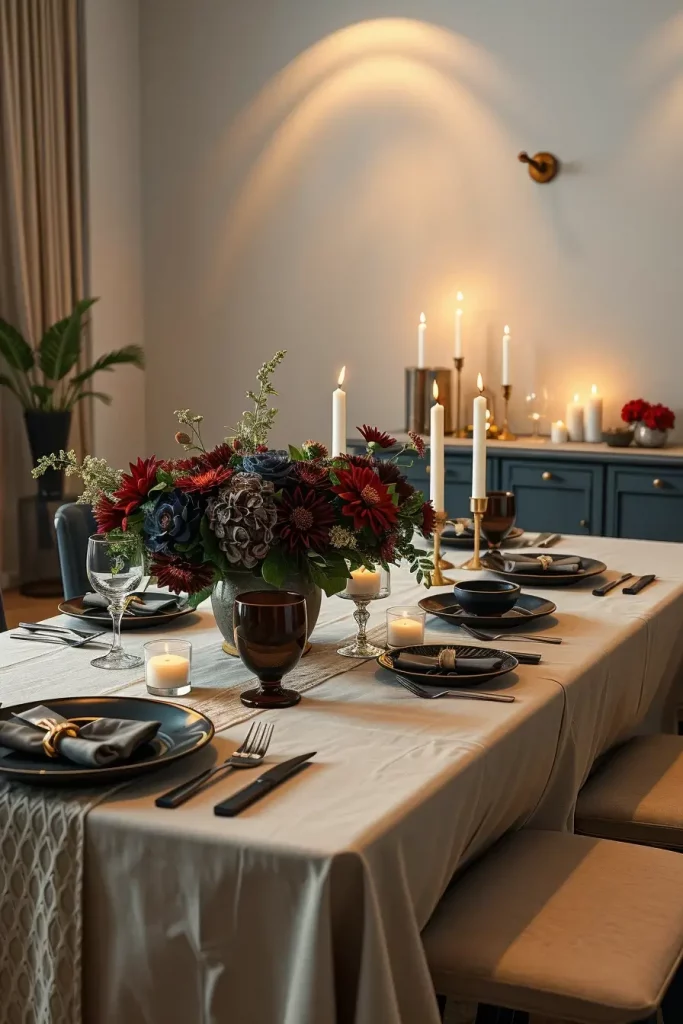
Practically, I’ll incorporate matte ceramic plates (charcoal or bone), brushed-black cutlery, smoked glass goblets, and individual place cards with wax seals. It is all about texture: stone coasters, hammered metal chargers, and velvet ribbons around napkins say rich without adding more. A tiny projection mapping trick: a short-throw projector casting slow-moving, barely-there shadows (swarming bats, drifting clouds) on a nearby wall adds an immersive layer without distracting from the meal.
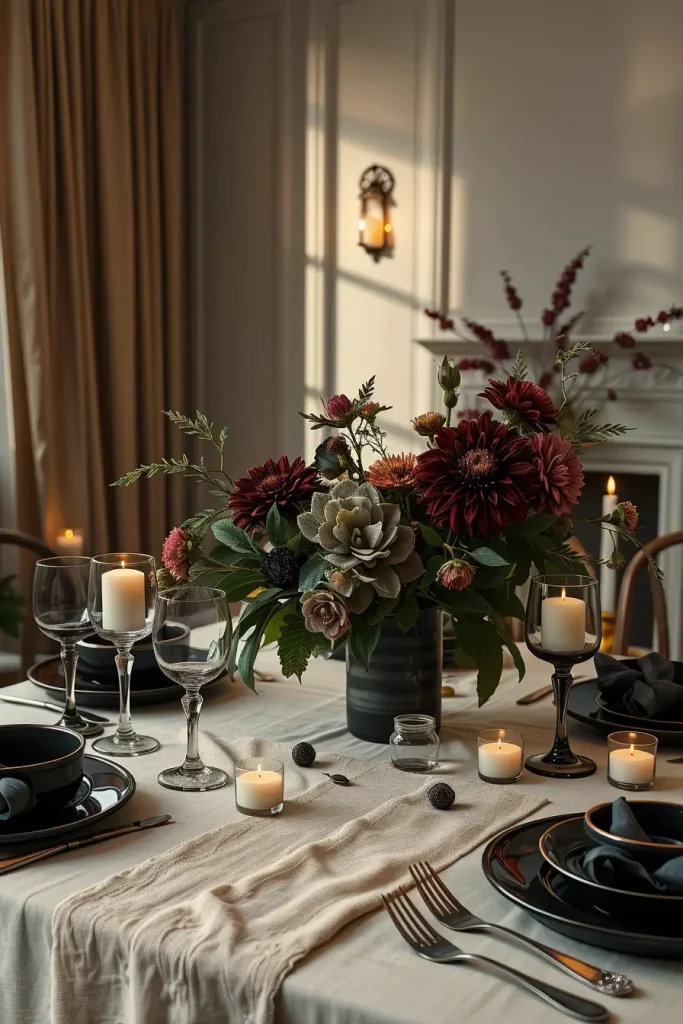
I think that good Halloween tablescapes do not use plastic as much as possible. The editorial staff of AD often reminds the readers that restrained palette with high materiality is better than maximal gimmicks. I’ll use reusable ceramic pumpkins, beeswax candles (cleaner burn, better scent), and real gourds sprayed matte for longevity.
What’s missing? High odor management. I’d add unscented candles for the table (so fragrance doesn’t compete with food) and keep scented elements to the adjacent buffet or entry console. Also look at low-noise fog machines under the buffet to produce an atmospheric veil that does not blow over plates.
Projection Mapping, AR Mirrors And Smart Lights: High-Tech Haunts
I take a high-tech haunt just as seriously as lighting design: begin with a plan, not the device. I map one architectural surface—usually a clean wall or ceiling—with a subtle loop (cracking plaster, crawling vines, spectral shadows). Then I add an AR mirror by the entry that overlays a ghostly silhouette or distortion when someone walks up (there are 2025 consumer-level mirrors that do this with no coding). Lastly, I overlay intelligent light scenes, warm candlelight in the early evening, cooler moonlight blues in the late night.
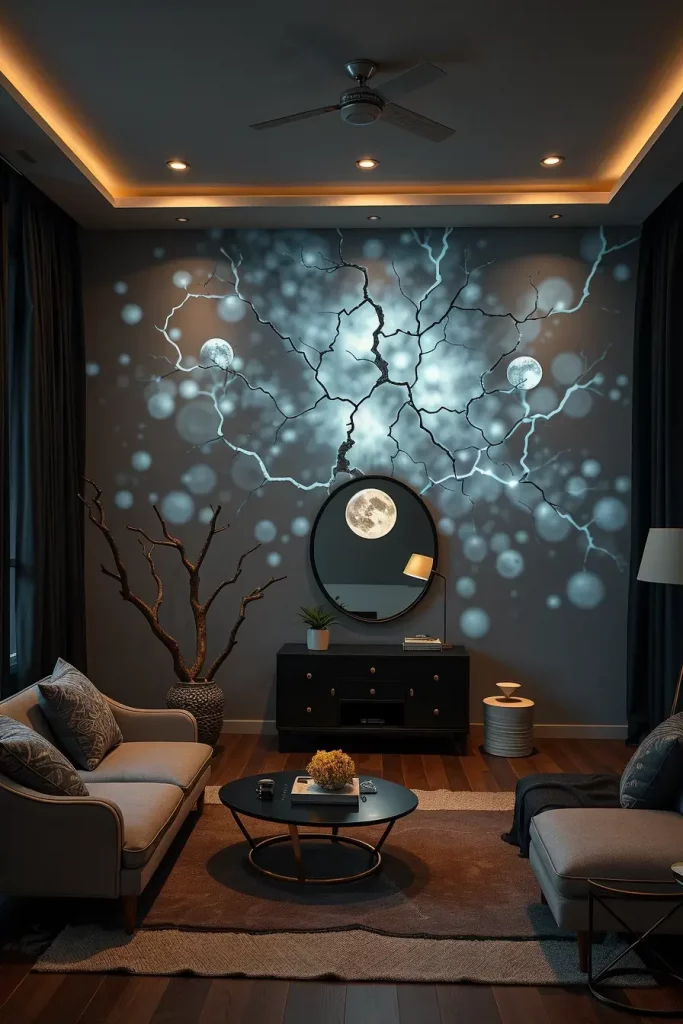
On the gear front, I rely on ultra-short-throw projectors to avoid complex installations, HomeKit or Matter-compatible bulbs/strips to control everything in one place, and motion sensors to set audio or lights to go off as people move around. I conceal projectors in black painted boxes or bookcases to preserve the look. This tech is all surrounded by very analog decor, matte black drapes, textural rugs, and sculptural branches, so the space does not feel like a tech demo.
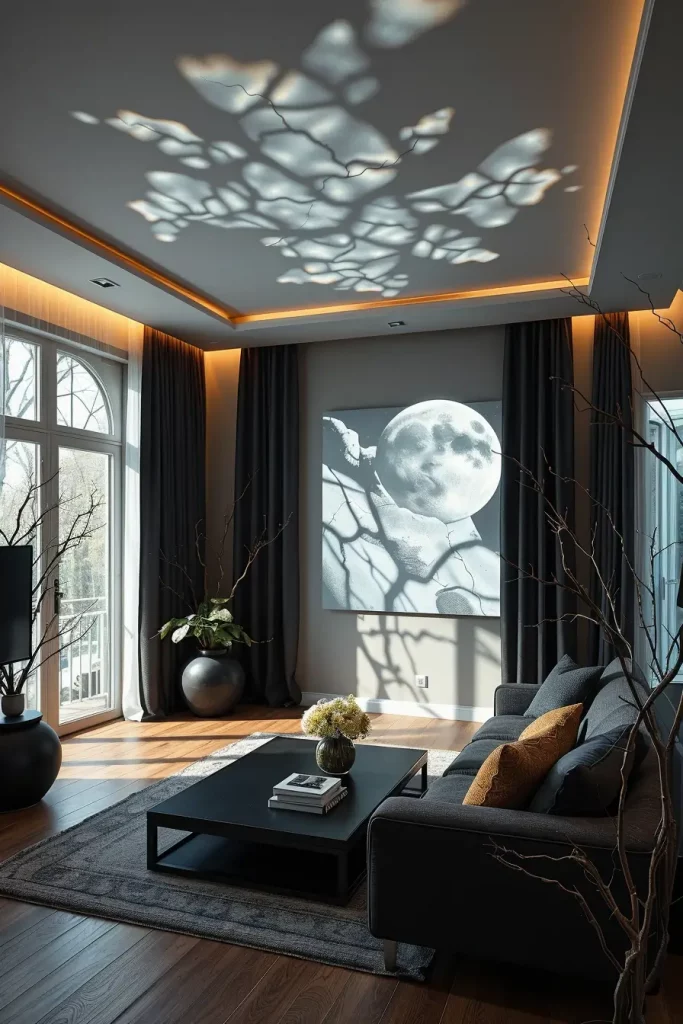
Less is more, as experience shows. I would prefer to have one ideal haunting projection at cinematic quality than have low-res visuals all over the place. The lighting designers usually recommend aiming at 27003000K to get a candle-like appearance and 40005000K to get a moonlight oneI stick to this rule in order to make the colors plausible.
What’s missing? A back-up manual mode. I always program a simple static scene (flickering warm dim + ambient shadows) in case connectivity hiccups on party night. I also add tactile, low-tech details (e.g., an old trunk with props) so if the tech goes dark, the space still reads atmospheric.
Sustainable And Reusable Halloween Decor: Materials, Storage And Circularity
I consider sustainable Halloween as a system: materials, modularity and storage. I invest in pieces that either look good off-season (think black ceramic vessels, concrete pumpkins, linen runners) or collapse neatly for minimal volume. I am not using glitter, cheap plastics, and anything that cannot be recycled or composted; I will paint the frames I buy in thrift stores and turn glass jars into potion bottles.
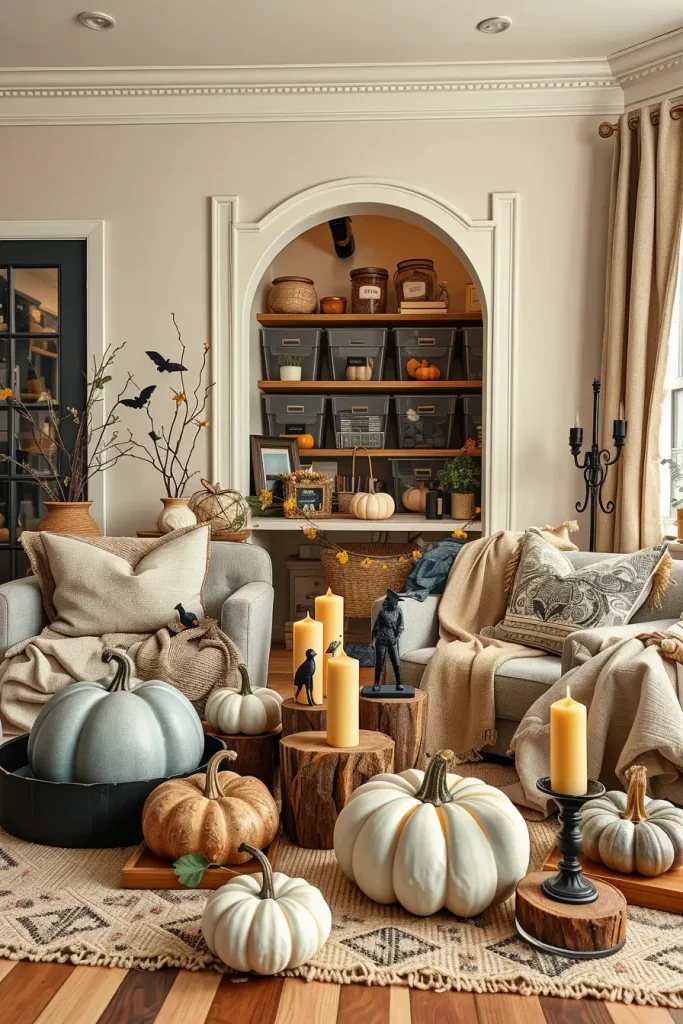
My kit: beeswax candles, cotton gauze, linen tablecloths, fiberboard or recycled cardboard silhouettes, PLA 3D-printed accents (biodegradable), and modular risers made from reclaimed wood. I keep in clear labeled bins with silica packs to keep them longer. In the case of textiles, vacuum bags conserve grave space, particularly in micro-spaces.
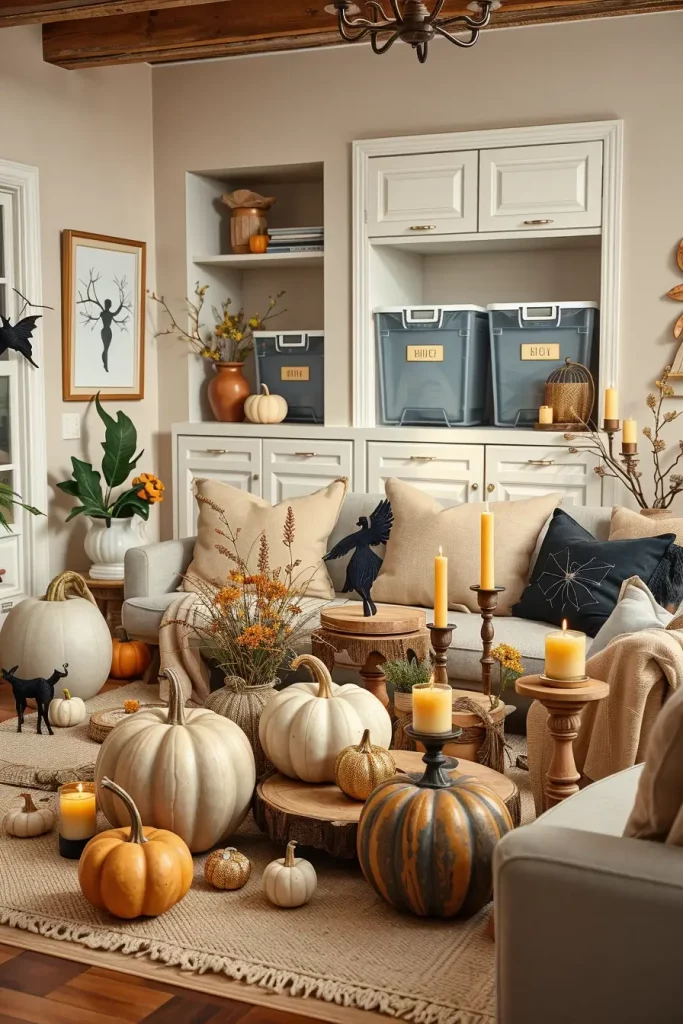
Professionally, I’ve seen clients save hundreds by curating a “Halloween core palette” (matte black, bone, rust, smoke) and buying quality basics they remix every year. Durability is, as sustainability writer Alden Wicker is fond of pointing out, the most underrated eco strategy, buy once, use forever.
Missing? A disposal/repair strategy. I carry a small kit: matte black touch up paint, fabric dye to fix stained linens and a glue/epoxy set to fix chips. And I will post decor I have grown out of on local buy-nothing groups and then look at the trash.
Scent, Sound And Fog Machines: Multisensory Atmospheres At Home
I make a Halloween interior memorable by designing nose and ears as well as eyes. I layer scent with essential-oil diffusers (smoke, cedar, clove) in the entry, unscented beeswax at the table, and a subtle ozonic fog from low-lying fog machines in hallways or stairwells. Sound is zoned: low bass rumble loop in the foyer, crackling fireplace and distant whispers in the living room and playful mischief effects in the powder room.
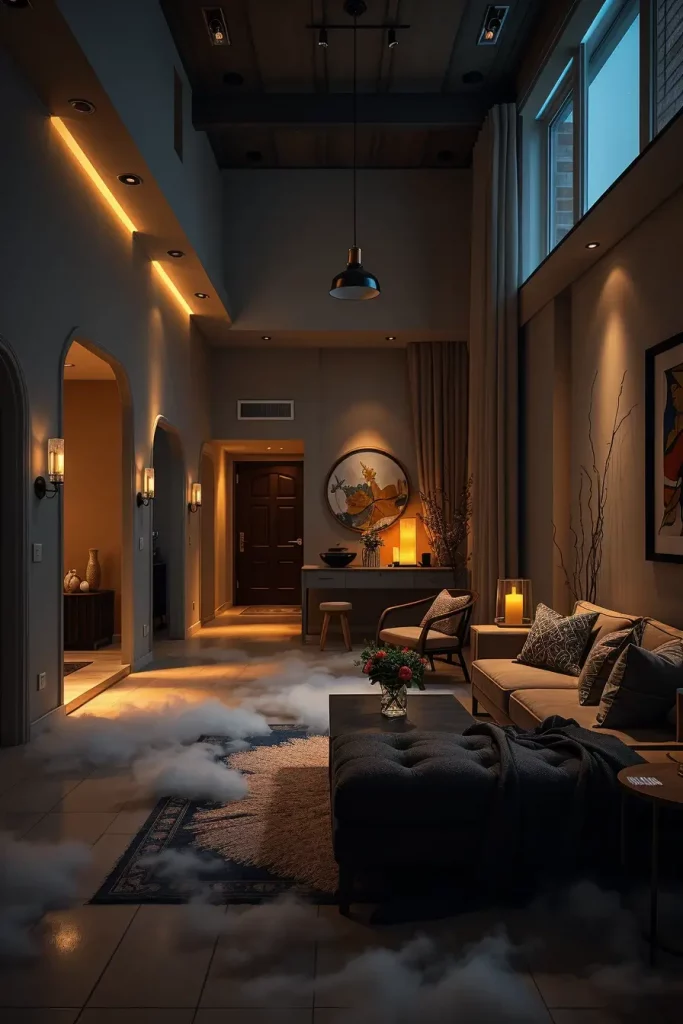
On the gear front, I like ultrasonic diffusers that have timers, small Bluetooth speakers that can be concealed behind drapery, and silent foggers that can be controlled by DMX or an app so they do not sputter on and off constantly. I will raise machines on shallow trays to avoid floors and put them behind furniture where there is still airflow.
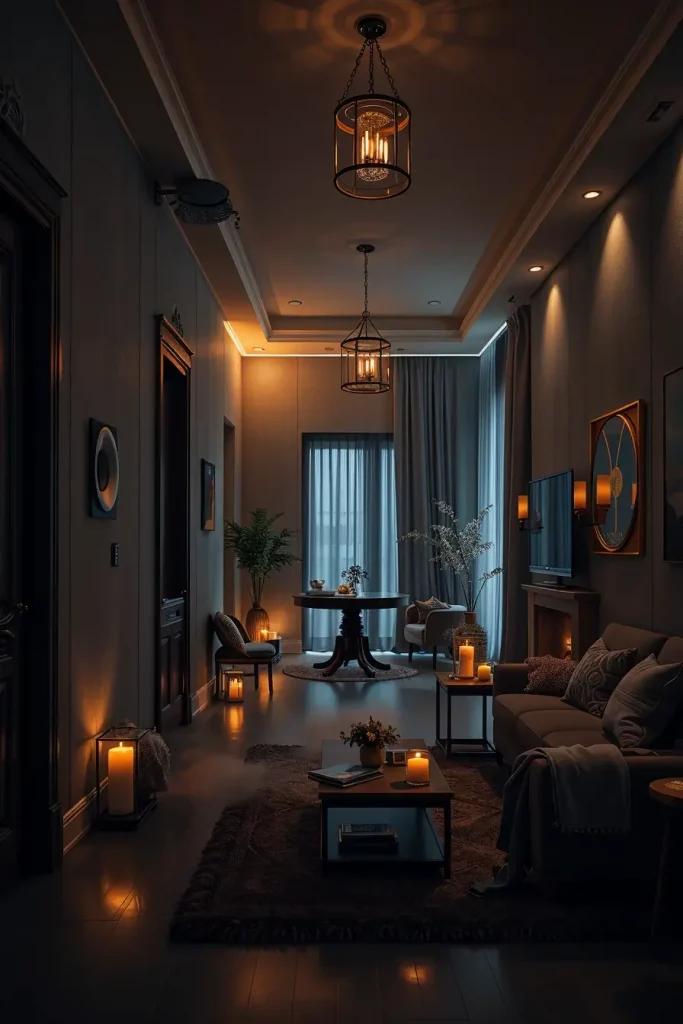
In my own tests, subtlety is the winner. When a smell is overbearing, the second people call it fake. According to the top hospitality scent designers, perfect background fragrance is at ~12 on a 10-point scale of intensity, just enough to smell, never enough to name. I reproduce that advice at home.
Missing? Fresh-air resets. I schedule brief window-venting moments (or turn on the HRV) between guest waves so the mix stays clean and intentional, not stale. I will also have a button on my lighting app that will turn down sound and fog immediately in case anyone feels overwhelmed, a so-called quiet scene.
Pet-Safe Halloween Home Decor: Non-Toxic, Low-Noise, No-Tangle
I pet-proof decor as I child-proof: nothing within tail-reach to swing on, nothing within nose-reach to chew, and nothing to startle with an unexpected burst of noise or light. I skip glitter, essential oils that are unsafe for cats/dogs (like tea tree), and delicate glass in high-traffic zones. I prefer soft fabrics, silicone flameless candles, and firmly fastened props instead. Pet-safe fog fluid (propylene glycol + glycerin, labeled safe) is non-negotiable.
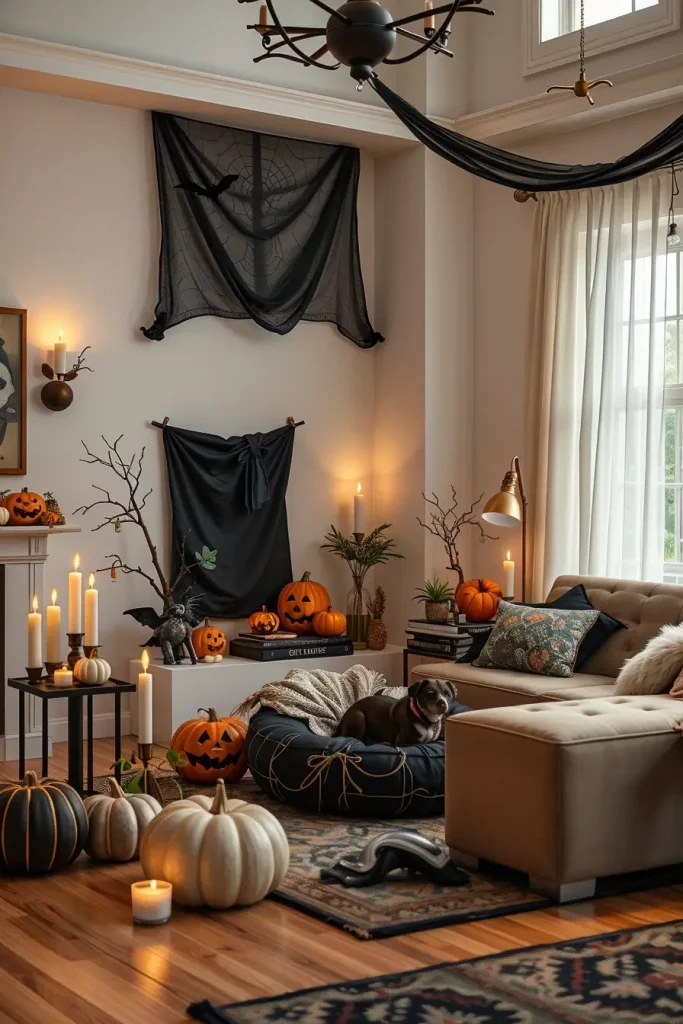
I place cables within cord covers or raceways, use heavy, tip-resistant statues and maintain low-noise smart lighting flicker effects over strobing. To take photos or costumes, I create a quiet corner with a washable black muslin background, soft LED lights, and snacks, so the animal decides on the interaction.
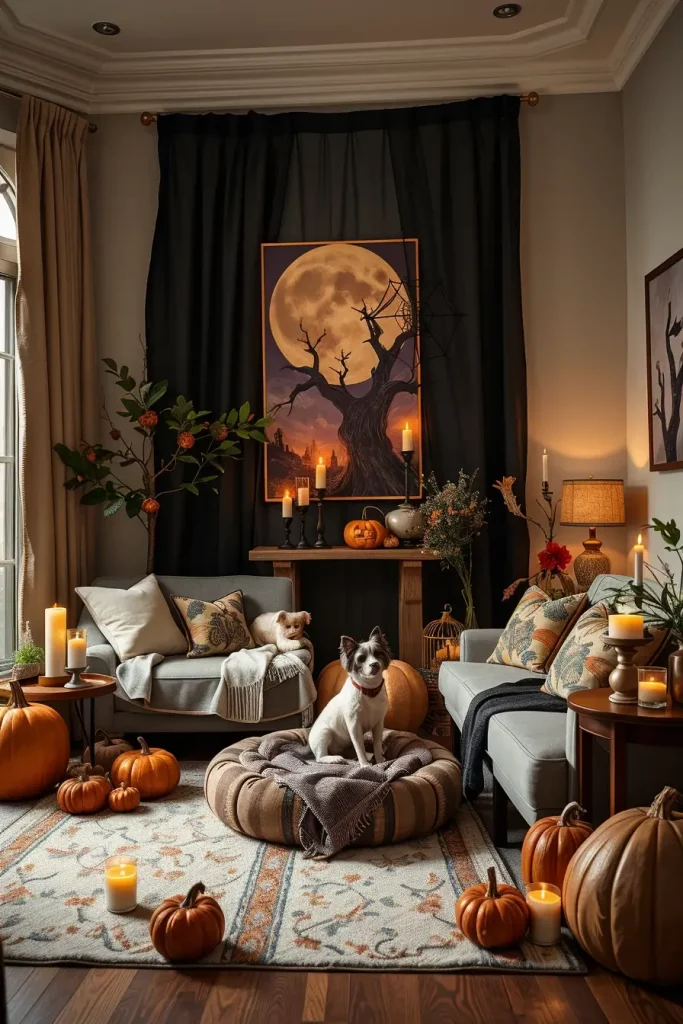
On a personal level, I have learned to audit all the scenes at the level of an animal. I redesign it, if it can be chewed, swallowed, or toppled. Veterinary advisories regularly warn against open-flame candles, faux spider webs (ingestion hazard), and tiny plastic bones—so I simply don’t use them anywhere pets roam.
Missing? A retreat area. I will always have one undecorated, quiet room with fresh water, familiar bedding, and no scent diffusers. And I set a low, constant lighting scene there so that animals can unwind.
Micro-Spaces And Apartments: High-Impact Ideas For Small Homes
When living in a small apartment or even in a micro-space, Halloween decor must provide the most atmosphere with the least clutter. I use vertical surfaces, doors, mirrors, windows, so I do not waste valuable square footage. Some stick-on LED candles on shelves on the wall, some sheer black curtains with a backlight, and some hanging paper silhouettes of ravens or crescent moons can make it in a minute. I use the space as a stage: concentrate the energy on a single wall and leave the rest breathable.
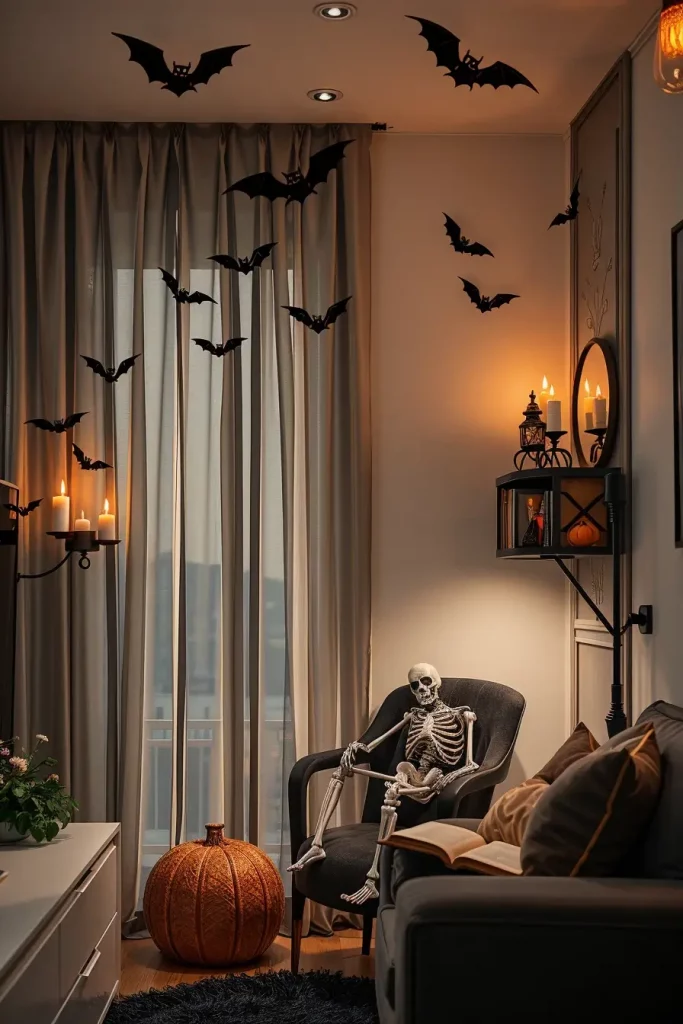
I rely on space-saving items like foldable black room dividers wrapped in faux vines or cheesecloth, magnetic bat decals that can be reused on any metal surface, and ultra-thin smart lighting strips (under furniture or along wall corners) to cast eerie uplight without visible cords. I will include a mirror or two to increase the visual space, and place props, such as a small skeleton in an armchair or a fake spellbook on a floating shelf, so that they lead the eye upwards.
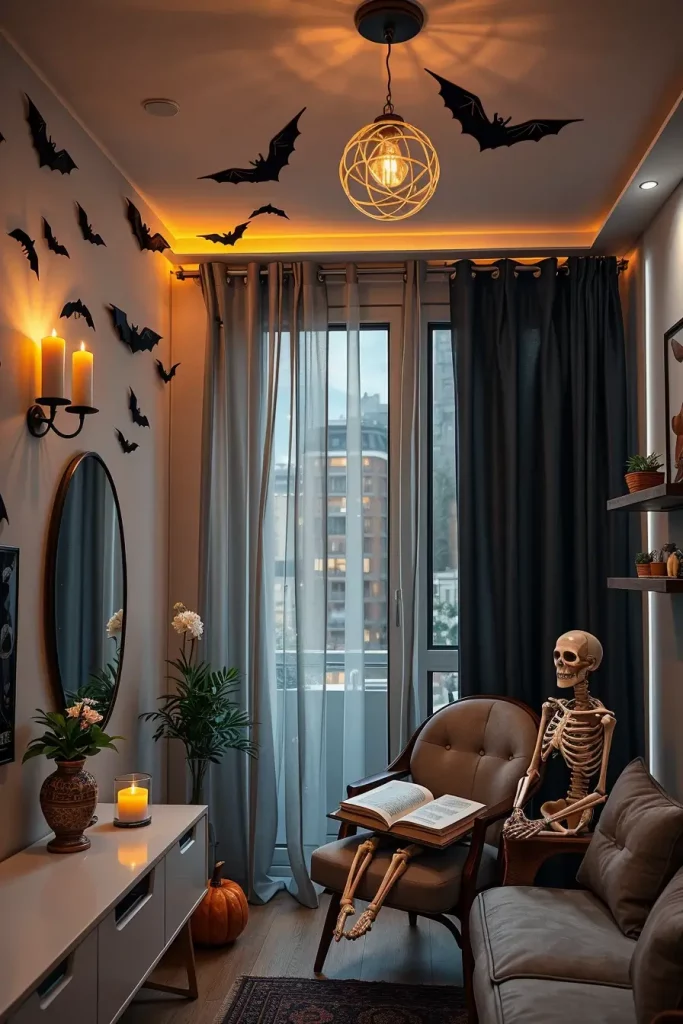
I know that most apartment residents feel that they cannot do big with Halloween home decor ideas 2025, but I have learned that less, but strategically placed items can be even more effective. This method has been emphasized by Apartment Therapy on several occasions: even a 400-square-foot studio can be immersive with the well-designed lighting, scent, and sound. I always recommend to my clients not to over-decorate, particularly in shared living areas, as the atmosphere should not turn into a mess.
What’s missing? Interactive elements. A sound chip that can be activated by motion behind a picture frame or an AR filter station through a mounted tablet can make the space more elevated without occupying space in micro-spaces. I would also recommend mirrors or dark reflective panels to reinforce lighting effects and make them visually twice as much.
Airbnb And Rental-Friendly Halloween Decor: Zero-Damage Tricks
My philosophy when it comes to renting spaces is that all the spooky touches need to peel, lift, or fold on November 1. That translates to Command hooks, museum putty, tension rods, peel-and-stick decals, and battery-powered lighting as Halloween home decor ideas 2025. I prefer to begin with the envelope–windows, door frames, curtain rods–and overlay reversible elements which will look permanent, but not cost you your deposit.
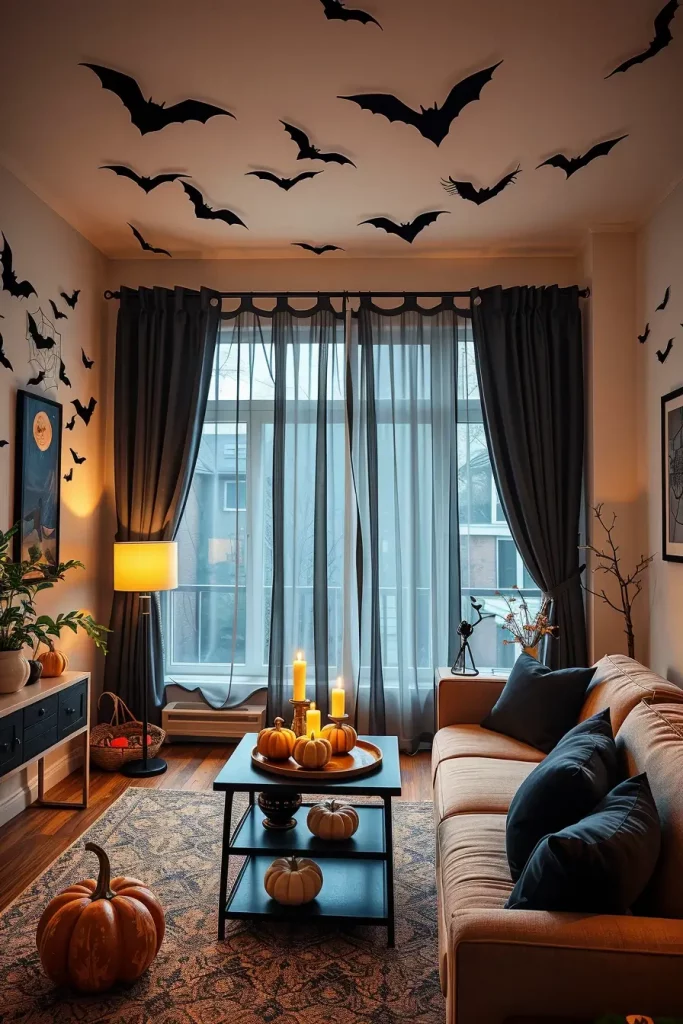
Matte-black peel-and-stick bats, removable spiderweb window clings, fabric tension-rod curtains in midnight velvet, flameless taper candles with remote dimmers, lightweight gauze over lampshades, and collapsible cardboard or foam-core tombstones to place in entry corners, item by item, I reach. A slim black runner over a console, a bowl of black sand with bone-handled cocktail stirrers, and monochrome pumpkins (spray-painted with water-based, easily strippable paint on paper tape) round out the vignette.
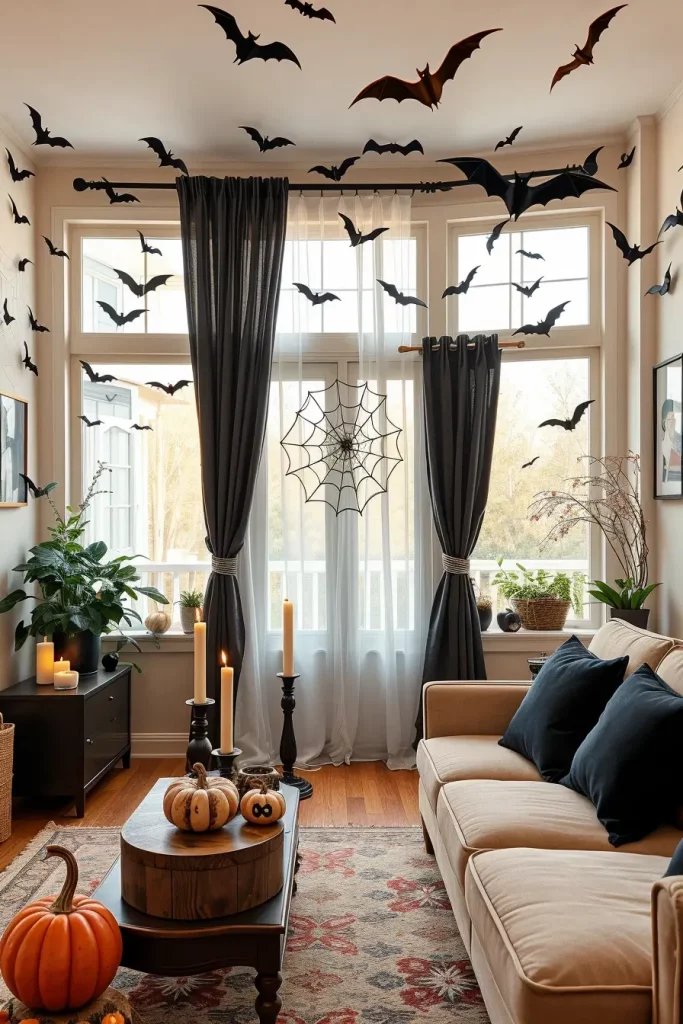
Through experience, I have found that layering lighting sells the mood the most- Apartment Therapy has reiterated many times on flexible, low-commitment light sources to renters, and I concur. I will frequently place puck lights beneath gauze in order to achieve that creepy underglow without tapping into hardwiring.
What’s missing? When you are hosting, put some scent in it, but make it renter-friendly as well: plug-ins or reed diffusers in smoky vanilla or bonfire tones. I also include QR-coded Wi-Fi “guest cards” in a small prop that looks like a spell book, both as a useful prop and a fun one.
Aesthetic Social-Media Moments: Photo Walls, Reels Corners And Hashtag Props
When clients are asking to have Halloween decor that will pay off on Instagram or TikTok, I create a special mini-set, a single wall or corner that is optimally framed to shoot vertical video. I design it in the same way a production designer would: foreground prop, midground texture, background anchor. The remainder of the house can remain understated; the corner does all the work.
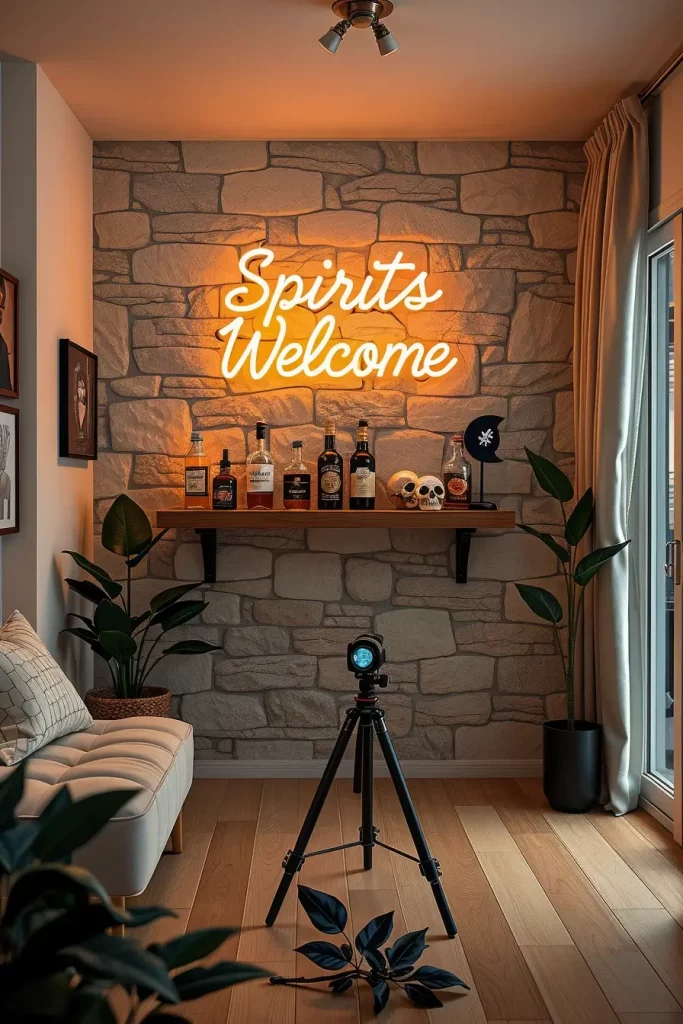
I build it with a peel‑and‑stick backdrop (glossy black tile effect or moody faux stone), a floating ledge for curated props (vintage apothecary bottles, matte skulls, moon mirrors), an LED neon sign (e.g., “Spirits Welcome”), and a floor scatter of black faux leaves. The floor markers in the form of tripods guarantee that your phone will always get the same flattering angle. I also add a custom hashtag branded lightbox or acrylic prop.

Personally, I’ve found that a tight color palette (two neutrals + one accent) photographs best—AD’s shoots lean into this discipline, and it translates perfectly to social decor. I suggest you put your phone on 4K/60 to get buttery slow-motion flicker shots of magical lighting or floating candles.
What’s missing? Movement. Add a small, silent oscillating fan to provide gauze, ribbons, or hanging moons with a little bit of drift to make them seem magical in front of the camera.
Last-Minute Halloween Home Decor Ideas 2025: 30-Minute Transformations
When I am in a pinch, I go to three levers: color blocking, massed repetition, smart light. I’ll drape a black tablecloth over any visible surface (console, island, coffee table), cluster 9–12 pillar candles (battery, varied heights), and dump a bag of mini plastic spiders into clear cylinders for creepy, fast texture.
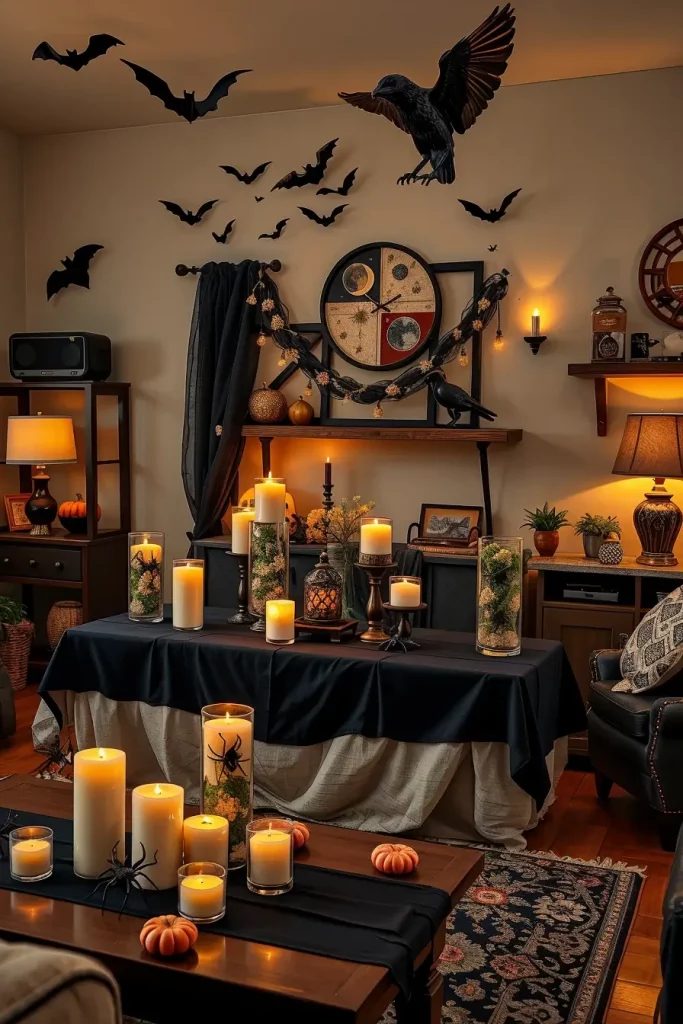
I keep a “panic kit”: matte-black spray paint (cardboard-safe), peel‑and‑stick eyes for mirrors, battery tea lights, black cheesecloth, and printable “poison” labels to slap on existing pantry jars. Put in two statement props, oversized crow and moon phase garland, and the room becomes “fully decorated” in minutes.
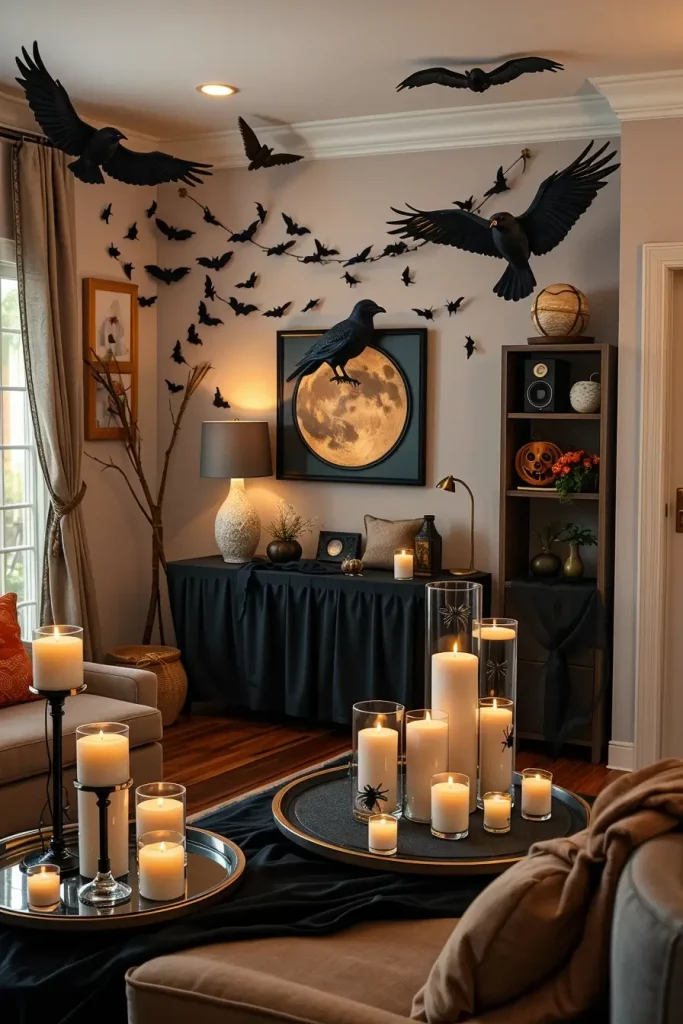
In my experience, massing identical items (dozens of paper bats, a grid of black frames with printable vintage horror illustrations) always looks intentional—even if it took 15 minutes. Volume and repetition are shortcut tools of cohesion, as stylist Emily Henderson likes to point out.
Missing? Audio. The least expensive ambience multiplier that most people overlook is a Bluetooth speaker playing wind chimes, creaking doors, or low strings in a loop.
Classic Black Cats, Crows And Moon Motifs In Modern Settings
To update in 2025, I reduce these icons to graphic shadows, tone-on-tone textures, and high-end finishes. Imagine matte-black ceramic cats, brass crescent moons, and jet-black feathered crows on acrylic stands, no kitsch, all contour. I will make walls neutral and drive the drama with high contrast lighting and sculptural placement.
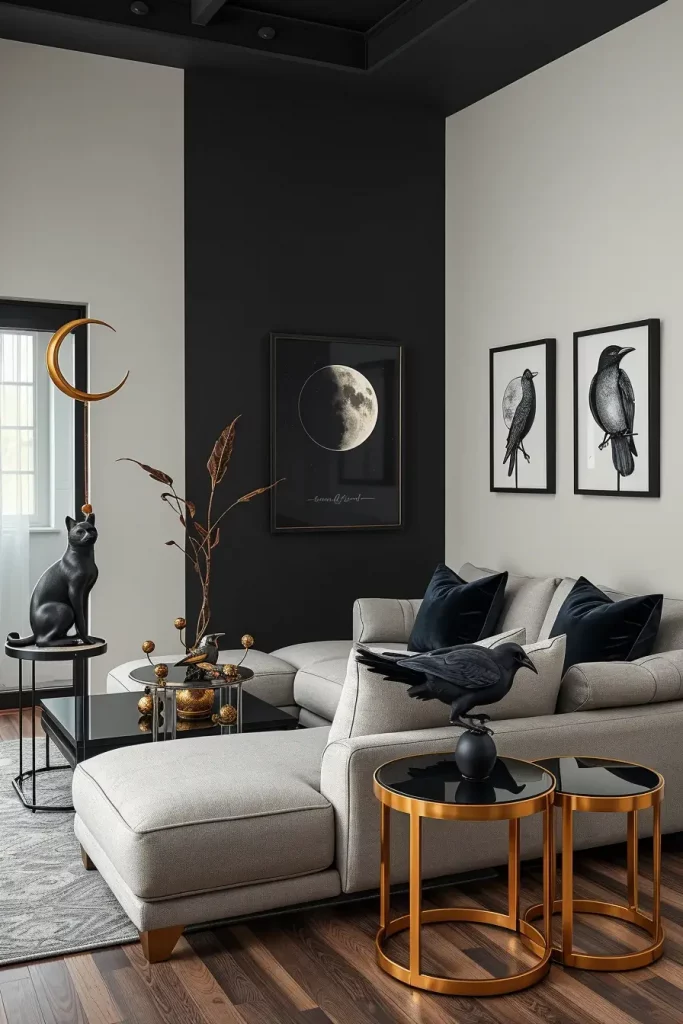
I design sculptural crescent floor lamps, black and white lunar phase art in narrow black frames, and a selected set of midnight velvet cushions on a neutral modular sofa. A trio of black-and-gold nesting side tables are stacked and used as candle and obsidian stone altars. Crows perch on top of modern books (“Supernatural Minimalism,” anyone?) to keep the vignette witty, not childish.
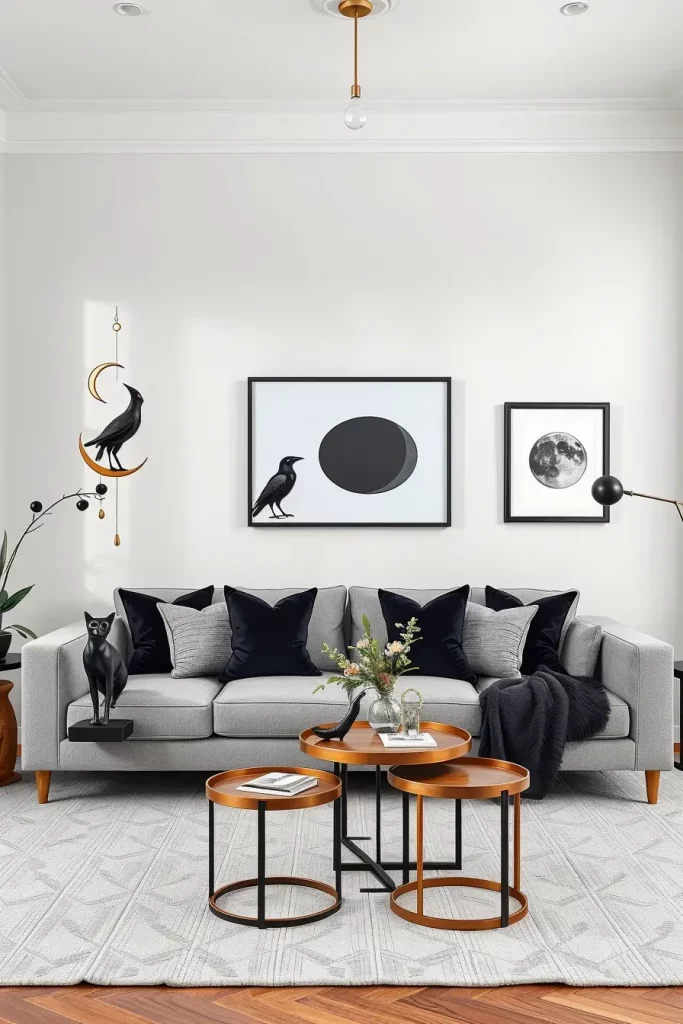
My take: these motifs are sophisticated because of restraint. Editing is design, as Domino keeps reminding the readers. I would rather have one beautiful brass moon mobile than have fifty odds and ends.
What is lacking in most rooms? Texture depth. Contrast boucle, velvet, lacquer, and matte in deliberate contrast–photographs and human eyes alike adore the range of the touch.
Floating Candles, Hidden Fans And Enchanted Lighting Effects
There is nothing that sells Halloween like motion light and shadow. I rig floating candles with ultra-fine fishing line and strong removable ceiling hooks, and add a micro-fan to have gauzy fabric and lightweight paper moons drift. I zone lighting into ambient (warm dimmable LEDs), accent (spotlight on a “spell table”), and kinetic (candles that flicker randomly).
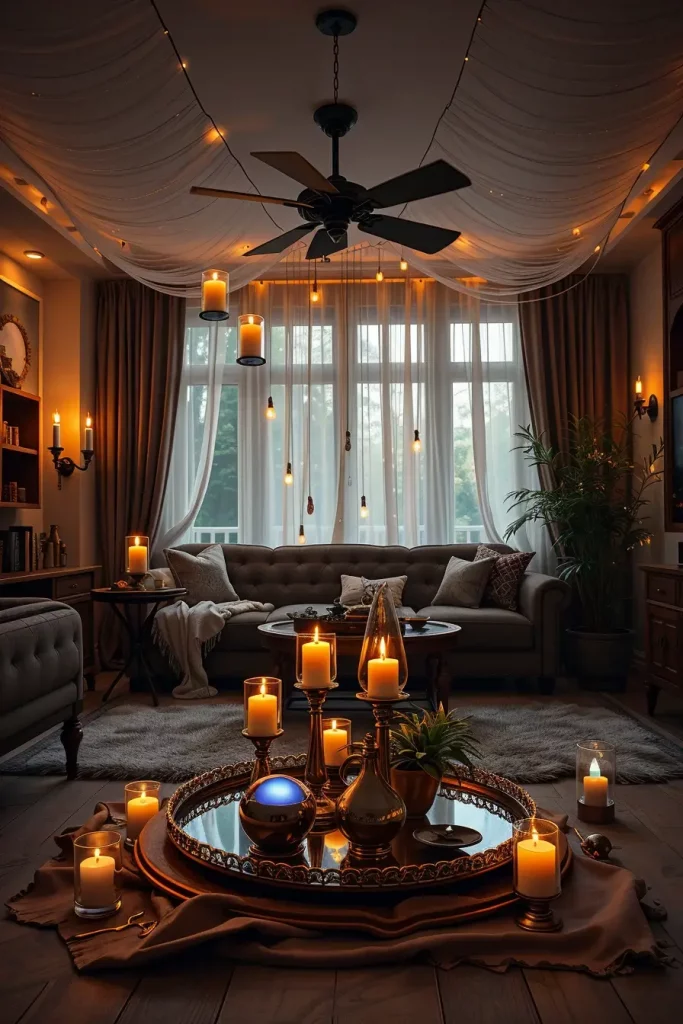
My kit: battery-operated taper candles with remote timers, magnetic rechargeable puck lights tucked inside pumpkins, RGB smart bulbs set to warm amber and desaturated blue, and a theatrical haze machine (tiny, water-based) for one-off parties. I shall also introduce reflective metals, antique brass trays, pieces of mirror, to reflect candlelight and multiply the glow.
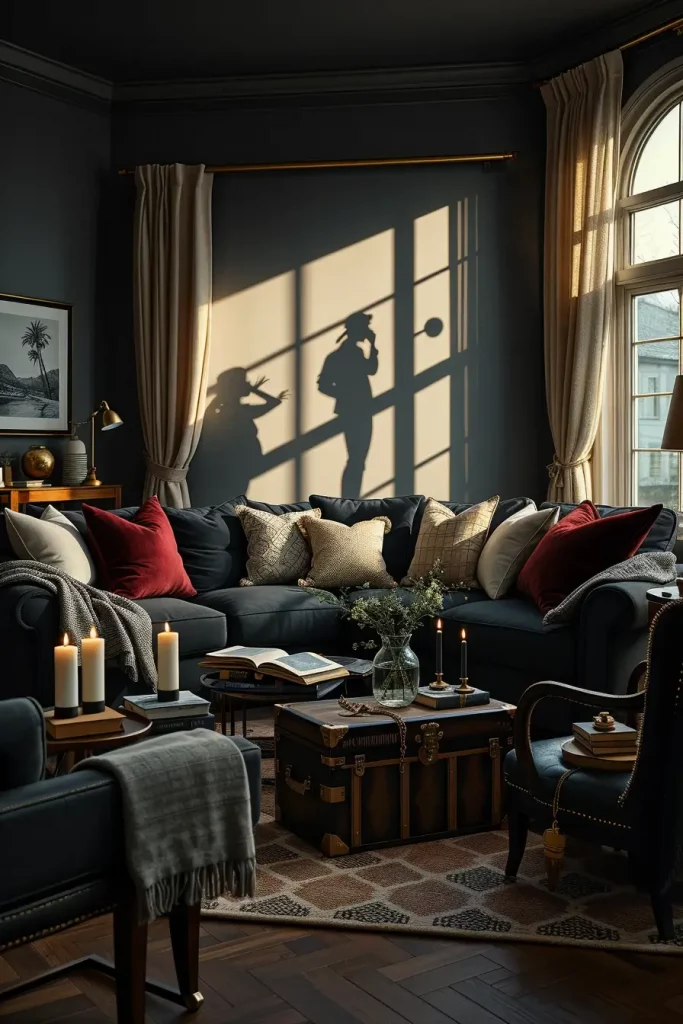
I have tried dozens of flameless candles; the random-flicker ones with jagged-looking melt edges look most realistic on camera and in real life. Lighting designer tips from theater (directional, layered, motivated sources) translate beautifully at home—light as if every effect had a narrative source.
Missing? Security and management. Label the remotes, set timers, and develop a master off routine in your smart home app to make teardown fast and foolproof.
Halloween in 2025 is no longer just about cobwebs and carved pumpkins—it’s about creating immersive, thoughtful, and even tech-driven experiences that reflect your lifestyle and values. Whether you’re staging a skeleton comedy show or building a sensory-rich, sustainable haunted vignette, the key is to be intentional. Combine classic with seasonal, buy items that you can use again and never forget about the comfort of pets, kids, and guests.
Love an idea or a creative spin on one of these ideas? I’d love to hear how you’re styling your space this year—drop a comment and let’s keep the ideas haunting and inspiring.
